GVC Start-up Selection: A Decision-Making Model Using Fuzzy TOPSIS
VerifiedAdded on 2023/01/18
|23
|13976
|84
AI Summary
This research paper introduces a decision-making model employing the intuitionistic fuzzy Technique for Order Preference by Similarity to Ideal Solution (TOPSIS) method to enhance the selection of start-up businesses within a government venture capital (GVC) scheme. Addressing the prevalent issue of underperformance in GVC-funded start-ups due to factors like lack of transparency and biases, the proposed model aims to increase fairness and incorporate uncertainties in the selection criteria using fuzzy set theory. The methodology involves establishing relevant criteria, analyzing them using TOPSIS in an intuitionistic fuzzy environment, and aggregating decision-maker ratings with the intuitionistic fuzzy weighted averaging operator. By providing a numerical example, the paper demonstrates the practical application of the model in a competitive GVC setting, offering a valuable framework for improving the selection process and ensuring the support of start-ups with high potential for success.
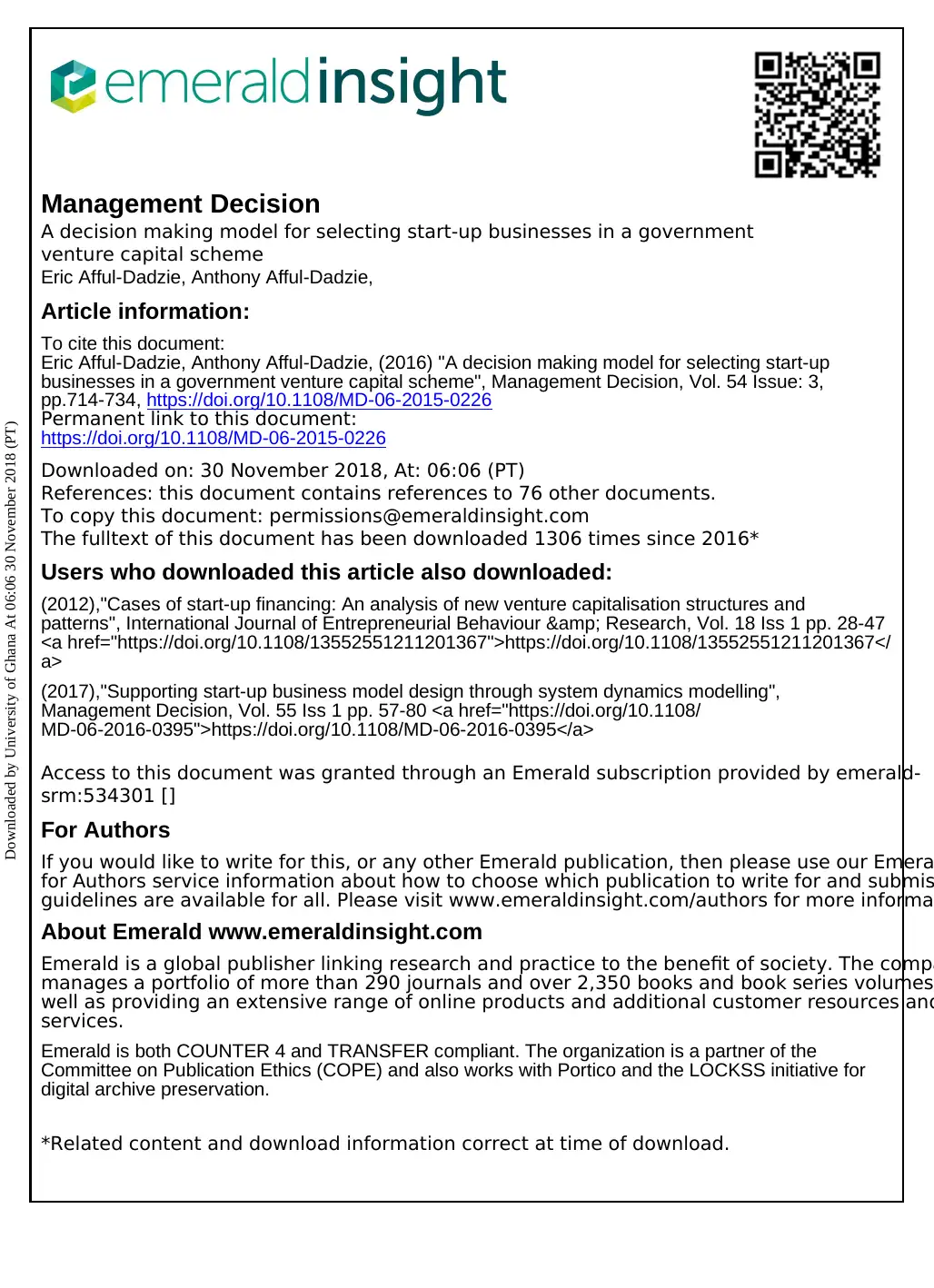
Management Decision
A decision making model for selecting start-up businesses in a government
venture capital scheme
Eric Afful-Dadzie, Anthony Afful-Dadzie,
Article information:
To cite this document:
Eric Afful-Dadzie, Anthony Afful-Dadzie, (2016) "A decision making model for selecting start-up
businesses in a government venture capital scheme", Management Decision, Vol. 54 Issue: 3,
pp.714-734, https://doi.org/10.1108/MD-06-2015-0226
Permanent link to this document:
https://doi.org/10.1108/MD-06-2015-0226
Downloaded on: 30 November 2018, At: 06:06 (PT)
References: this document contains references to 76 other documents.
To copy this document: permissions@emeraldinsight.com
The fulltext of this document has been downloaded 1306 times since 2016*
Users who downloaded this article also downloaded:
(2012),"Cases of start-up financing: An analysis of new venture capitalisation structures and
patterns", International Journal of Entrepreneurial Behaviour & Research, Vol. 18 Iss 1 pp. 28-47
<a href="https://doi.org/10.1108/13552551211201367">https://doi.org/10.1108/13552551211201367</
a>
(2017),"Supporting start-up business model design through system dynamics modelling",
Management Decision, Vol. 55 Iss 1 pp. 57-80 <a href="https://doi.org/10.1108/
MD-06-2016-0395">https://doi.org/10.1108/MD-06-2016-0395</a>
Access to this document was granted through an Emerald subscription provided by emerald-
srm:534301 []
For Authors
If you would like to write for this, or any other Emerald publication, then please use our Emera
for Authors service information about how to choose which publication to write for and submis
guidelines are available for all. Please visit www.emeraldinsight.com/authors for more informa
About Emerald www.emeraldinsight.com
Emerald is a global publisher linking research and practice to the benefit of society. The compa
manages a portfolio of more than 290 journals and over 2,350 books and book series volumes
well as providing an extensive range of online products and additional customer resources and
services.
Emerald is both COUNTER 4 and TRANSFER compliant. The organization is a partner of the
Committee on Publication Ethics (COPE) and also works with Portico and the LOCKSS initiative for
digital archive preservation.
*Related content and download information correct at time of download.
Downloaded by University of Ghana At 06:06 30 November 2018 (PT)
A decision making model for selecting start-up businesses in a government
venture capital scheme
Eric Afful-Dadzie, Anthony Afful-Dadzie,
Article information:
To cite this document:
Eric Afful-Dadzie, Anthony Afful-Dadzie, (2016) "A decision making model for selecting start-up
businesses in a government venture capital scheme", Management Decision, Vol. 54 Issue: 3,
pp.714-734, https://doi.org/10.1108/MD-06-2015-0226
Permanent link to this document:
https://doi.org/10.1108/MD-06-2015-0226
Downloaded on: 30 November 2018, At: 06:06 (PT)
References: this document contains references to 76 other documents.
To copy this document: permissions@emeraldinsight.com
The fulltext of this document has been downloaded 1306 times since 2016*
Users who downloaded this article also downloaded:
(2012),"Cases of start-up financing: An analysis of new venture capitalisation structures and
patterns", International Journal of Entrepreneurial Behaviour & Research, Vol. 18 Iss 1 pp. 28-47
<a href="https://doi.org/10.1108/13552551211201367">https://doi.org/10.1108/13552551211201367</
a>
(2017),"Supporting start-up business model design through system dynamics modelling",
Management Decision, Vol. 55 Iss 1 pp. 57-80 <a href="https://doi.org/10.1108/
MD-06-2016-0395">https://doi.org/10.1108/MD-06-2016-0395</a>
Access to this document was granted through an Emerald subscription provided by emerald-
srm:534301 []
For Authors
If you would like to write for this, or any other Emerald publication, then please use our Emera
for Authors service information about how to choose which publication to write for and submis
guidelines are available for all. Please visit www.emeraldinsight.com/authors for more informa
About Emerald www.emeraldinsight.com
Emerald is a global publisher linking research and practice to the benefit of society. The compa
manages a portfolio of more than 290 journals and over 2,350 books and book series volumes
well as providing an extensive range of online products and additional customer resources and
services.
Emerald is both COUNTER 4 and TRANSFER compliant. The organization is a partner of the
Committee on Publication Ethics (COPE) and also works with Portico and the LOCKSS initiative for
digital archive preservation.
*Related content and download information correct at time of download.
Downloaded by University of Ghana At 06:06 30 November 2018 (PT)
Paraphrase This Document
Need a fresh take? Get an instant paraphrase of this document with our AI Paraphraser
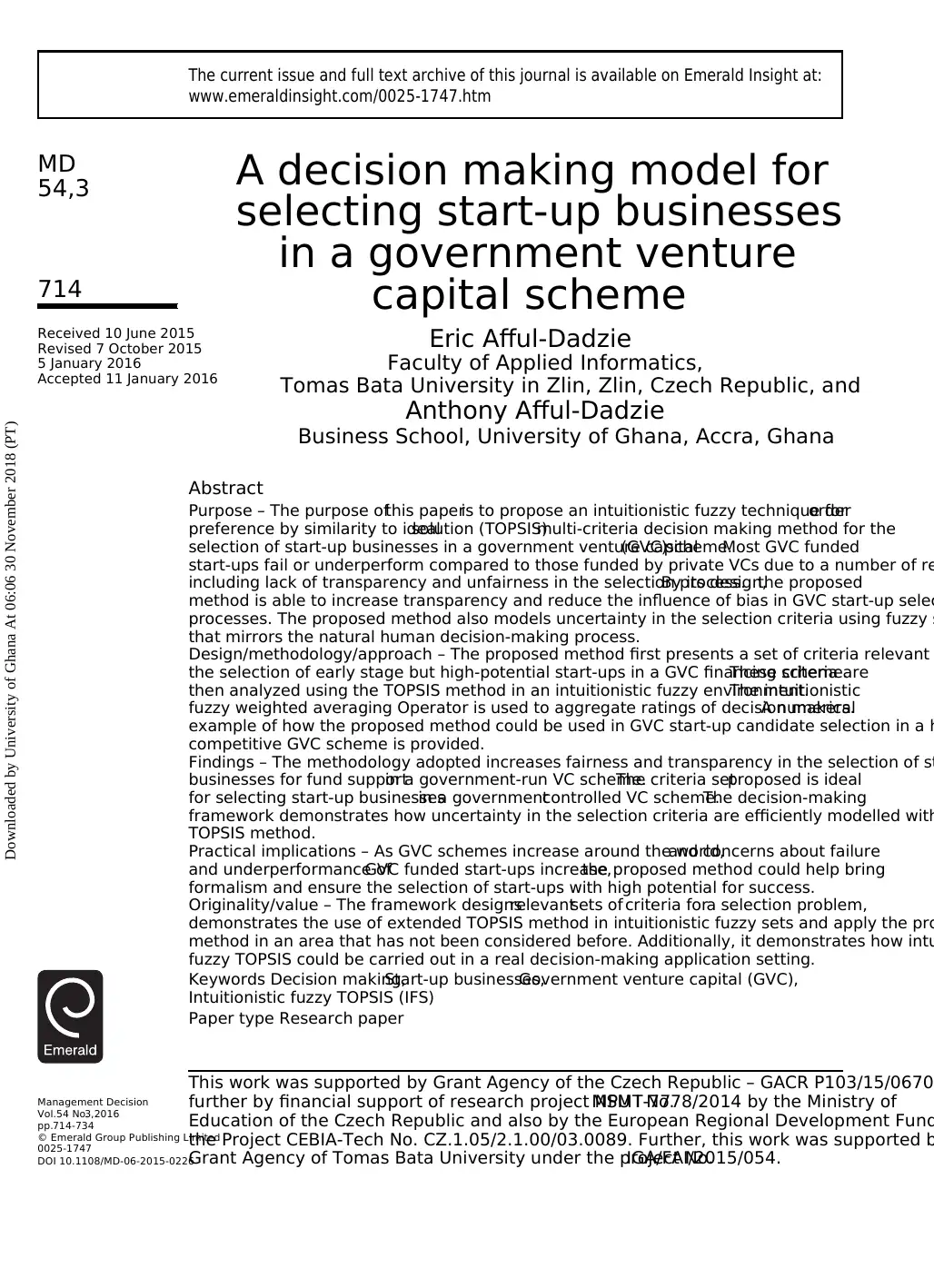
A decision making model for
selecting start-up businesses
in a government venture
capital scheme
Eric Afful-Dadzie
Faculty of Applied Informatics,
Tomas Bata University in Zlin, Zlin, Czech Republic, and
Anthony Afful-Dadzie
Business School, University of Ghana, Accra, Ghana
Abstract
Purpose – The purpose ofthis paperis to propose an intuitionistic fuzzy technique fororder
preference by similarity to idealsolution (TOPSIS)multi-criteria decision making method for the
selection of start-up businesses in a government venture capital(GVC)scheme.Most GVC funded
start-ups fail or underperform compared to those funded by private VCs due to a number of re
including lack of transparency and unfairness in the selection process.By its design,the proposed
method is able to increase transparency and reduce the influence of bias in GVC start-up selec
processes. The proposed method also models uncertainty in the selection criteria using fuzzy s
that mirrors the natural human decision-making process.
Design/methodology/approach – The proposed method first presents a set of criteria relevant
the selection of early stage but high-potential start-ups in a GVC financing scheme.These criteria are
then analyzed using the TOPSIS method in an intuitionistic fuzzy environment.The intuitionistic
fuzzy weighted averaging Operator is used to aggregate ratings of decision makers.A numerical
example of how the proposed method could be used in GVC start-up candidate selection in a h
competitive GVC scheme is provided.
Findings – The methodology adopted increases fairness and transparency in the selection of st
businesses for fund supportin a government-run VC scheme.The criteria setproposed is ideal
for selecting start-up businessesin a governmentcontrolled VC scheme.The decision-making
framework demonstrates how uncertainty in the selection criteria are efficiently modelled with
TOPSIS method.
Practical implications – As GVC schemes increase around the world,and concerns about failure
and underperformance ofGVC funded start-ups increase,the proposed method could help bring
formalism and ensure the selection of start-ups with high potential for success.
Originality/value – The framework designsrelevantsets of criteria fora selection problem,
demonstrates the use of extended TOPSIS method in intuitionistic fuzzy sets and apply the pro
method in an area that has not been considered before. Additionally, it demonstrates how intu
fuzzy TOPSIS could be carried out in a real decision-making application setting.
Keywords Decision making,Start-up businesses,Government venture capital (GVC),
Intuitionistic fuzzy TOPSIS (IFS)
Paper type Research paper
Management Decision
Vol.54 No.3,2016
pp.714-734
© Emerald Group Publishing Limited
0025-1747
DOI 10.1108/MD-06-2015-0226
Received 10 June 2015
Revised 7 October 2015
5 January 2016
Accepted 11 January 2016
The current issue and full text archive of this journal is available on Emerald Insight at:
www.emeraldinsight.com/0025-1747.htm
This work was supported by Grant Agency of the Czech Republic – GACR P103/15/0670
further by financial support of research project NPU I No.MSMT-7778/2014 by the Ministry of
Education of the Czech Republic and also by the European Regional Development Fund
the Project CEBIA-Tech No. CZ.1.05/2.1.00/03.0089. Further, this work was supported b
Grant Agency of Tomas Bata University under the project No.IGA/FAI/2015/054.
714
MD
54,3
Downloaded by University of Ghana At 06:06 30 November 2018 (PT)
selecting start-up businesses
in a government venture
capital scheme
Eric Afful-Dadzie
Faculty of Applied Informatics,
Tomas Bata University in Zlin, Zlin, Czech Republic, and
Anthony Afful-Dadzie
Business School, University of Ghana, Accra, Ghana
Abstract
Purpose – The purpose ofthis paperis to propose an intuitionistic fuzzy technique fororder
preference by similarity to idealsolution (TOPSIS)multi-criteria decision making method for the
selection of start-up businesses in a government venture capital(GVC)scheme.Most GVC funded
start-ups fail or underperform compared to those funded by private VCs due to a number of re
including lack of transparency and unfairness in the selection process.By its design,the proposed
method is able to increase transparency and reduce the influence of bias in GVC start-up selec
processes. The proposed method also models uncertainty in the selection criteria using fuzzy s
that mirrors the natural human decision-making process.
Design/methodology/approach – The proposed method first presents a set of criteria relevant
the selection of early stage but high-potential start-ups in a GVC financing scheme.These criteria are
then analyzed using the TOPSIS method in an intuitionistic fuzzy environment.The intuitionistic
fuzzy weighted averaging Operator is used to aggregate ratings of decision makers.A numerical
example of how the proposed method could be used in GVC start-up candidate selection in a h
competitive GVC scheme is provided.
Findings – The methodology adopted increases fairness and transparency in the selection of st
businesses for fund supportin a government-run VC scheme.The criteria setproposed is ideal
for selecting start-up businessesin a governmentcontrolled VC scheme.The decision-making
framework demonstrates how uncertainty in the selection criteria are efficiently modelled with
TOPSIS method.
Practical implications – As GVC schemes increase around the world,and concerns about failure
and underperformance ofGVC funded start-ups increase,the proposed method could help bring
formalism and ensure the selection of start-ups with high potential for success.
Originality/value – The framework designsrelevantsets of criteria fora selection problem,
demonstrates the use of extended TOPSIS method in intuitionistic fuzzy sets and apply the pro
method in an area that has not been considered before. Additionally, it demonstrates how intu
fuzzy TOPSIS could be carried out in a real decision-making application setting.
Keywords Decision making,Start-up businesses,Government venture capital (GVC),
Intuitionistic fuzzy TOPSIS (IFS)
Paper type Research paper
Management Decision
Vol.54 No.3,2016
pp.714-734
© Emerald Group Publishing Limited
0025-1747
DOI 10.1108/MD-06-2015-0226
Received 10 June 2015
Revised 7 October 2015
5 January 2016
Accepted 11 January 2016
The current issue and full text archive of this journal is available on Emerald Insight at:
www.emeraldinsight.com/0025-1747.htm
This work was supported by Grant Agency of the Czech Republic – GACR P103/15/0670
further by financial support of research project NPU I No.MSMT-7778/2014 by the Ministry of
Education of the Czech Republic and also by the European Regional Development Fund
the Project CEBIA-Tech No. CZ.1.05/2.1.00/03.0089. Further, this work was supported b
Grant Agency of Tomas Bata University under the project No.IGA/FAI/2015/054.
714
MD
54,3
Downloaded by University of Ghana At 06:06 30 November 2018 (PT)
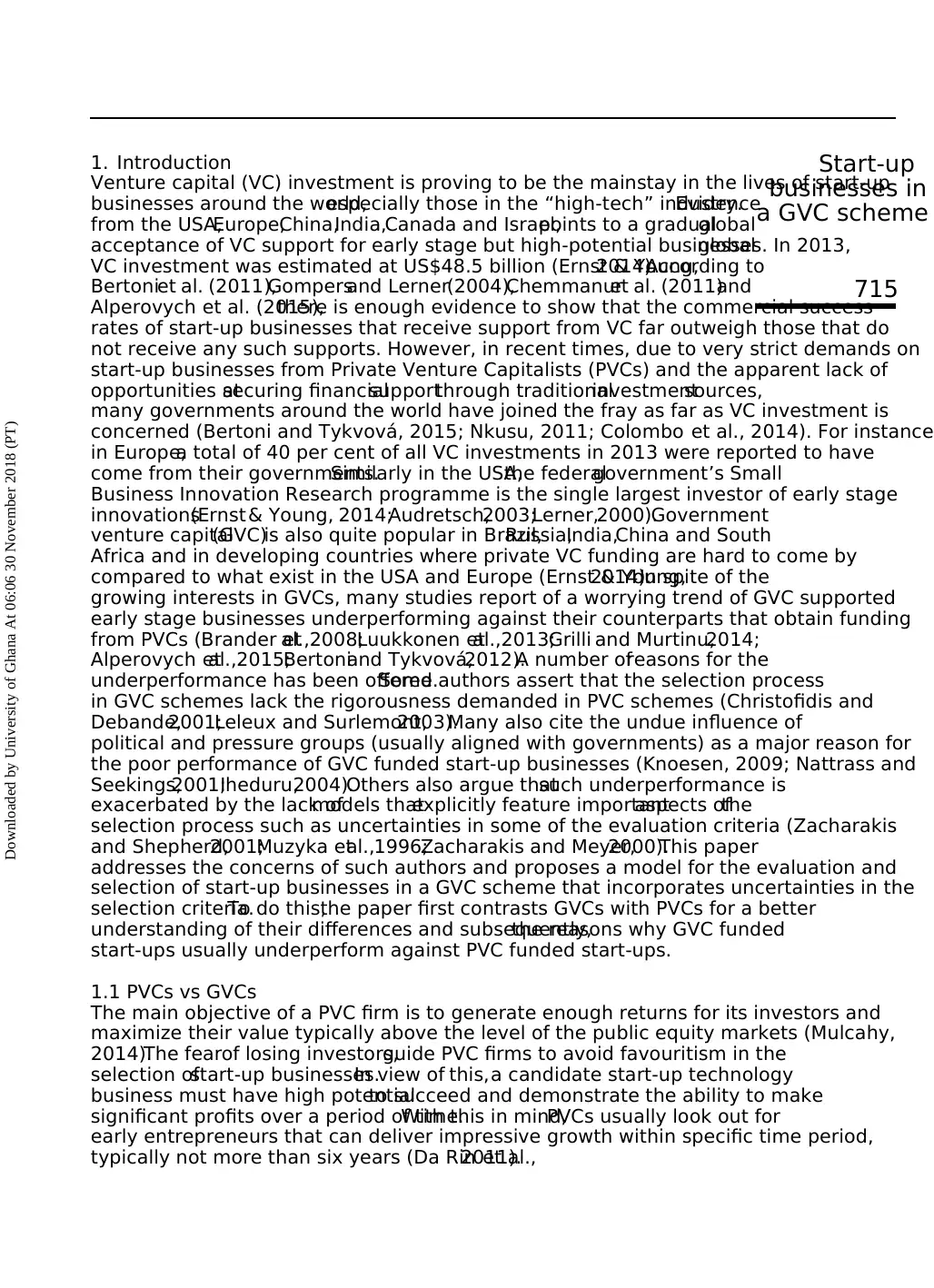
1. Introduction
Venture capital (VC) investment is proving to be the mainstay in the lives of start-up
businesses around the world,especially those in the “high-tech” industry.Evidence
from the USA,Europe,China,India,Canada and Israel,points to a gradualglobal
acceptance of VC support for early stage but high-potential businesses. In 2013,global
VC investment was estimated at US$48.5 billion (Ernst & Young,2014).According to
Bertoniet al. (2011),Gompersand Lerner(2004),Chemmanuret al. (2011)and
Alperovych et al. (2015),there is enough evidence to show that the commercial success
rates of start-up businesses that receive support from VC far outweigh those that do
not receive any such supports. However, in recent times, due to very strict demands on
start-up businesses from Private Venture Capitalists (PVCs) and the apparent lack of
opportunities atsecuring financialsupportthrough traditionalinvestmentsources,
many governments around the world have joined the fray as far as VC investment is
concerned (Bertoni and Tykvová, 2015; Nkusu, 2011; Colombo et al., 2014). For instance
in Europe,a total of 40 per cent of all VC investments in 2013 were reported to have
come from their governments.Similarly in the USA,the federalgovernment’s Small
Business Innovation Research programme is the single largest investor of early stage
innovations(Ernst & Young, 2014;Audretsch,2003;Lerner,2000).Government
venture capital(GVC)is also quite popular in Brazil,Russia,India,China and South
Africa and in developing countries where private VC funding are hard to come by
compared to what exist in the USA and Europe (Ernst & Young,2014).In spite of the
growing interests in GVCs, many studies report of a worrying trend of GVC supported
early stage businesses underperforming against their counterparts that obtain funding
from PVCs (Brander etal.,2008;Luukkonen etal.,2013;Grilli and Murtinu,2014;
Alperovych etal.,2015;Bertoniand Tykvová,2012).A number ofreasons for the
underperformance has been offered.Some authors assert that the selection process
in GVC schemes lack the rigorousness demanded in PVC schemes (Christofidis and
Debande,2001;Leleux and Surlemont,2003).Many also cite the undue influence of
political and pressure groups (usually aligned with governments) as a major reason for
the poor performance of GVC funded start-up businesses (Knoesen, 2009; Nattrass and
Seekings,2001;Iheduru,2004).Others also argue thatsuch underperformance is
exacerbated by the lack ofmodels thatexplicitly feature importantaspects ofthe
selection process such as uncertainties in some of the evaluation criteria (Zacharakis
and Shepherd,2001;Muzyka etal.,1996;Zacharakis and Meyer,2000).This paper
addresses the concerns of such authors and proposes a model for the evaluation and
selection of start-up businesses in a GVC scheme that incorporates uncertainties in the
selection criteria.To do this,the paper first contrasts GVCs with PVCs for a better
understanding of their differences and subsequently,the reasons why GVC funded
start-ups usually underperform against PVC funded start-ups.
1.1 PVCs vs GVCs
The main objective of a PVC firm is to generate enough returns for its investors and
maximize their value typically above the level of the public equity markets (Mulcahy,
2014).The fearof losing investors,guide PVC firms to avoid favouritism in the
selection ofstart-up businesses.In view of this,a candidate start-up technology
business must have high potentialto succeed and demonstrate the ability to make
significant profits over a period of time.With this in mind,PVCs usually look out for
early entrepreneurs that can deliver impressive growth within specific time period,
typically not more than six years (Da Rin et al.,2011).
715
Start-up
businesses in
a GVC scheme
Downloaded by University of Ghana At 06:06 30 November 2018 (PT)
Venture capital (VC) investment is proving to be the mainstay in the lives of start-up
businesses around the world,especially those in the “high-tech” industry.Evidence
from the USA,Europe,China,India,Canada and Israel,points to a gradualglobal
acceptance of VC support for early stage but high-potential businesses. In 2013,global
VC investment was estimated at US$48.5 billion (Ernst & Young,2014).According to
Bertoniet al. (2011),Gompersand Lerner(2004),Chemmanuret al. (2011)and
Alperovych et al. (2015),there is enough evidence to show that the commercial success
rates of start-up businesses that receive support from VC far outweigh those that do
not receive any such supports. However, in recent times, due to very strict demands on
start-up businesses from Private Venture Capitalists (PVCs) and the apparent lack of
opportunities atsecuring financialsupportthrough traditionalinvestmentsources,
many governments around the world have joined the fray as far as VC investment is
concerned (Bertoni and Tykvová, 2015; Nkusu, 2011; Colombo et al., 2014). For instance
in Europe,a total of 40 per cent of all VC investments in 2013 were reported to have
come from their governments.Similarly in the USA,the federalgovernment’s Small
Business Innovation Research programme is the single largest investor of early stage
innovations(Ernst & Young, 2014;Audretsch,2003;Lerner,2000).Government
venture capital(GVC)is also quite popular in Brazil,Russia,India,China and South
Africa and in developing countries where private VC funding are hard to come by
compared to what exist in the USA and Europe (Ernst & Young,2014).In spite of the
growing interests in GVCs, many studies report of a worrying trend of GVC supported
early stage businesses underperforming against their counterparts that obtain funding
from PVCs (Brander etal.,2008;Luukkonen etal.,2013;Grilli and Murtinu,2014;
Alperovych etal.,2015;Bertoniand Tykvová,2012).A number ofreasons for the
underperformance has been offered.Some authors assert that the selection process
in GVC schemes lack the rigorousness demanded in PVC schemes (Christofidis and
Debande,2001;Leleux and Surlemont,2003).Many also cite the undue influence of
political and pressure groups (usually aligned with governments) as a major reason for
the poor performance of GVC funded start-up businesses (Knoesen, 2009; Nattrass and
Seekings,2001;Iheduru,2004).Others also argue thatsuch underperformance is
exacerbated by the lack ofmodels thatexplicitly feature importantaspects ofthe
selection process such as uncertainties in some of the evaluation criteria (Zacharakis
and Shepherd,2001;Muzyka etal.,1996;Zacharakis and Meyer,2000).This paper
addresses the concerns of such authors and proposes a model for the evaluation and
selection of start-up businesses in a GVC scheme that incorporates uncertainties in the
selection criteria.To do this,the paper first contrasts GVCs with PVCs for a better
understanding of their differences and subsequently,the reasons why GVC funded
start-ups usually underperform against PVC funded start-ups.
1.1 PVCs vs GVCs
The main objective of a PVC firm is to generate enough returns for its investors and
maximize their value typically above the level of the public equity markets (Mulcahy,
2014).The fearof losing investors,guide PVC firms to avoid favouritism in the
selection ofstart-up businesses.In view of this,a candidate start-up technology
business must have high potentialto succeed and demonstrate the ability to make
significant profits over a period of time.With this in mind,PVCs usually look out for
early entrepreneurs that can deliver impressive growth within specific time period,
typically not more than six years (Da Rin et al.,2011).
715
Start-up
businesses in
a GVC scheme
Downloaded by University of Ghana At 06:06 30 November 2018 (PT)
⊘ This is a preview!⊘
Do you want full access?
Subscribe today to unlock all pages.

Trusted by 1+ million students worldwide
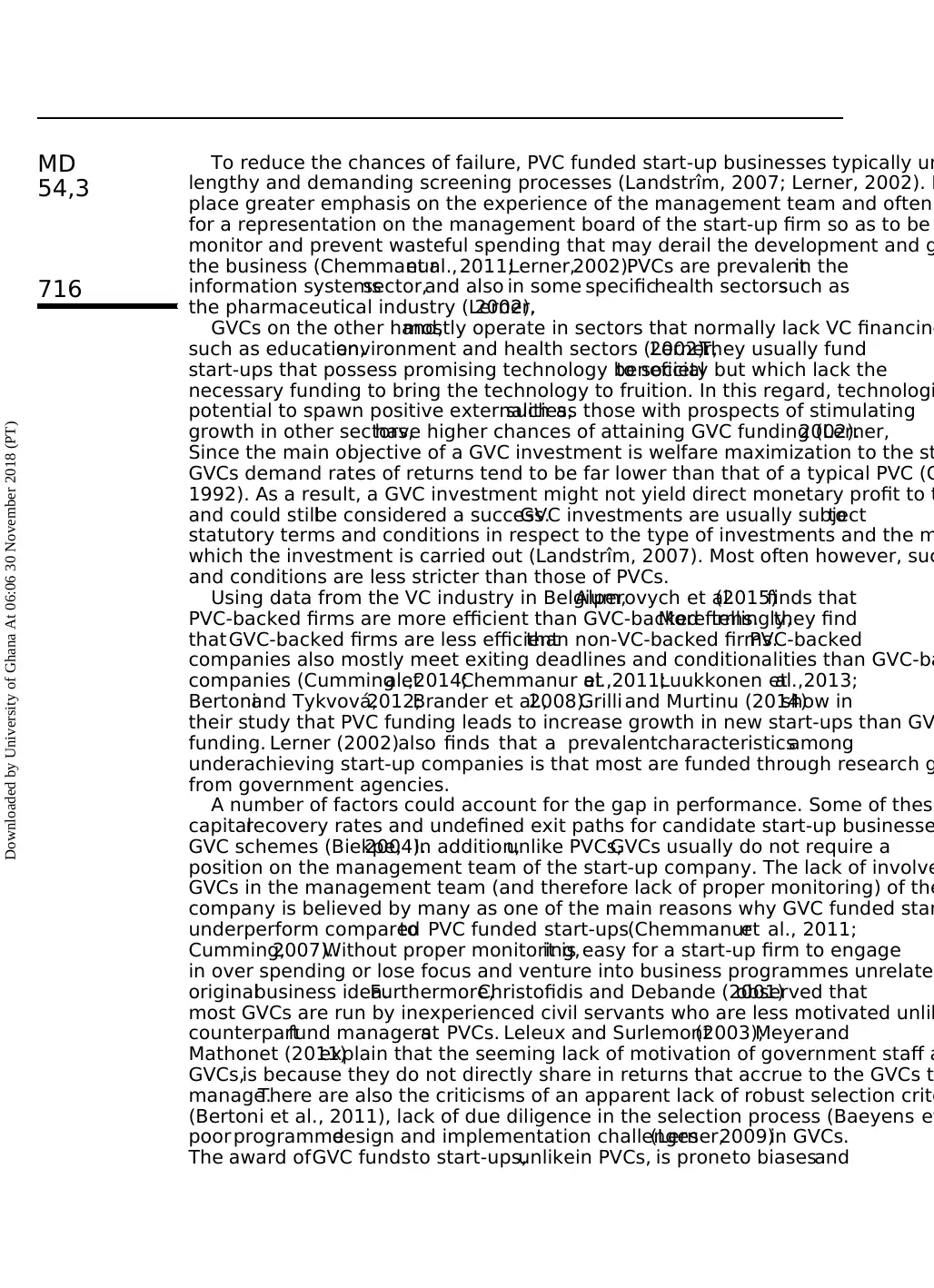
To reduce the chances of failure, PVC funded start-up businesses typically un
lengthy and demanding screening processes (Landstrîm, 2007; Lerner, 2002). P
place greater emphasis on the experience of the management team and often
for a representation on the management board of the start-up firm so as to be
monitor and prevent wasteful spending that may derail the development and g
the business (Chemmanuret al., 2011;Lerner,2002).PVCs are prevalentin the
information systemssector,and also in some specifichealth sectorssuch as
the pharmaceutical industry (Lerner,2002).
GVCs on the other hand,mostly operate in sectors that normally lack VC financing
such as education,environment and health sectors (Lerner,2002).They usually fund
start-ups that possess promising technology beneficialto society but which lack the
necessary funding to bring the technology to fruition. In this regard, technologi
potential to spawn positive externalities,such as those with prospects of stimulating
growth in other sectors,have higher chances of attaining GVC funding (Lerner,2002).
Since the main objective of a GVC investment is welfare maximization to the st
GVCs demand rates of returns tend to be far lower than that of a typical PVC (G
1992). As a result, a GVC investment might not yield direct monetary profit to t
and could stillbe considered a success.GVC investments are usually subjectto
statutory terms and conditions in respect to the type of investments and the m
which the investment is carried out (Landstrîm, 2007). Most often however, suc
and conditions are less stricter than those of PVCs.
Using data from the VC industry in Belgium,Alperovych et al.(2015)finds that
PVC-backed firms are more efficient than GVC-backed firms.More tellingly,they find
that GVC-backed firms are less efficientthan non-VC-backed firms.PVC-backed
companies also mostly meet exiting deadlines and conditionalities than GVC-ba
companies (Cumming etal.,2014;Chemmanur etal.,2011;Luukkonen etal.,2013;
Bertoniand Tykvová,2012;Brander et al.,2008).Grilli and Murtinu (2014)show in
their study that PVC funding leads to increase growth in new start-ups than GV
funding. Lerner (2002)also finds that a prevalentcharacteristicsamong
underachieving start-up companies is that most are funded through research g
from government agencies.
A number of factors could account for the gap in performance. Some of these
capitalrecovery rates and undefined exit paths for candidate start-up businesse
GVC schemes (Biekpe,2004).In addition,unlike PVCs,GVCs usually do not require a
position on the management team of the start-up company. The lack of involve
GVCs in the management team (and therefore lack of proper monitoring) of the
company is believed by many as one of the main reasons why GVC funded star
underperform comparedto PVC funded start-ups(Chemmanuret al., 2011;
Cumming,2007).Without proper monitoring,it is easy for a start-up firm to engage
in over spending or lose focus and venture into business programmes unrelated
originalbusiness idea.Furthermore,Christofidis and Debande (2001)observed that
most GVCs are run by inexperienced civil servants who are less motivated unlik
counterpartfund managersat PVCs. Leleux and Surlemont(2003);Meyerand
Mathonet (2011)explain that the seeming lack of motivation of government staff a
GVCs,is because they do not directly share in returns that accrue to the GVCs t
manage.There are also the criticisms of an apparent lack of robust selection crite
(Bertoni et al., 2011), lack of due diligence in the selection process (Baeyens et
poor programmedesign and implementation challenges(Lerner,2009)in GVCs.
The award ofGVC fundsto start-ups,unlikein PVCs, is proneto biasesand
716
MD
54,3
Downloaded by University of Ghana At 06:06 30 November 2018 (PT)
lengthy and demanding screening processes (Landstrîm, 2007; Lerner, 2002). P
place greater emphasis on the experience of the management team and often
for a representation on the management board of the start-up firm so as to be
monitor and prevent wasteful spending that may derail the development and g
the business (Chemmanuret al., 2011;Lerner,2002).PVCs are prevalentin the
information systemssector,and also in some specifichealth sectorssuch as
the pharmaceutical industry (Lerner,2002).
GVCs on the other hand,mostly operate in sectors that normally lack VC financing
such as education,environment and health sectors (Lerner,2002).They usually fund
start-ups that possess promising technology beneficialto society but which lack the
necessary funding to bring the technology to fruition. In this regard, technologi
potential to spawn positive externalities,such as those with prospects of stimulating
growth in other sectors,have higher chances of attaining GVC funding (Lerner,2002).
Since the main objective of a GVC investment is welfare maximization to the st
GVCs demand rates of returns tend to be far lower than that of a typical PVC (G
1992). As a result, a GVC investment might not yield direct monetary profit to t
and could stillbe considered a success.GVC investments are usually subjectto
statutory terms and conditions in respect to the type of investments and the m
which the investment is carried out (Landstrîm, 2007). Most often however, suc
and conditions are less stricter than those of PVCs.
Using data from the VC industry in Belgium,Alperovych et al.(2015)finds that
PVC-backed firms are more efficient than GVC-backed firms.More tellingly,they find
that GVC-backed firms are less efficientthan non-VC-backed firms.PVC-backed
companies also mostly meet exiting deadlines and conditionalities than GVC-ba
companies (Cumming etal.,2014;Chemmanur etal.,2011;Luukkonen etal.,2013;
Bertoniand Tykvová,2012;Brander et al.,2008).Grilli and Murtinu (2014)show in
their study that PVC funding leads to increase growth in new start-ups than GV
funding. Lerner (2002)also finds that a prevalentcharacteristicsamong
underachieving start-up companies is that most are funded through research g
from government agencies.
A number of factors could account for the gap in performance. Some of these
capitalrecovery rates and undefined exit paths for candidate start-up businesse
GVC schemes (Biekpe,2004).In addition,unlike PVCs,GVCs usually do not require a
position on the management team of the start-up company. The lack of involve
GVCs in the management team (and therefore lack of proper monitoring) of the
company is believed by many as one of the main reasons why GVC funded star
underperform comparedto PVC funded start-ups(Chemmanuret al., 2011;
Cumming,2007).Without proper monitoring,it is easy for a start-up firm to engage
in over spending or lose focus and venture into business programmes unrelated
originalbusiness idea.Furthermore,Christofidis and Debande (2001)observed that
most GVCs are run by inexperienced civil servants who are less motivated unlik
counterpartfund managersat PVCs. Leleux and Surlemont(2003);Meyerand
Mathonet (2011)explain that the seeming lack of motivation of government staff a
GVCs,is because they do not directly share in returns that accrue to the GVCs t
manage.There are also the criticisms of an apparent lack of robust selection crite
(Bertoni et al., 2011), lack of due diligence in the selection process (Baeyens et
poor programmedesign and implementation challenges(Lerner,2009)in GVCs.
The award ofGVC fundsto start-ups,unlikein PVCs, is proneto biasesand
716
MD
54,3
Downloaded by University of Ghana At 06:06 30 November 2018 (PT)
Paraphrase This Document
Need a fresh take? Get an instant paraphrase of this document with our AI Paraphraser
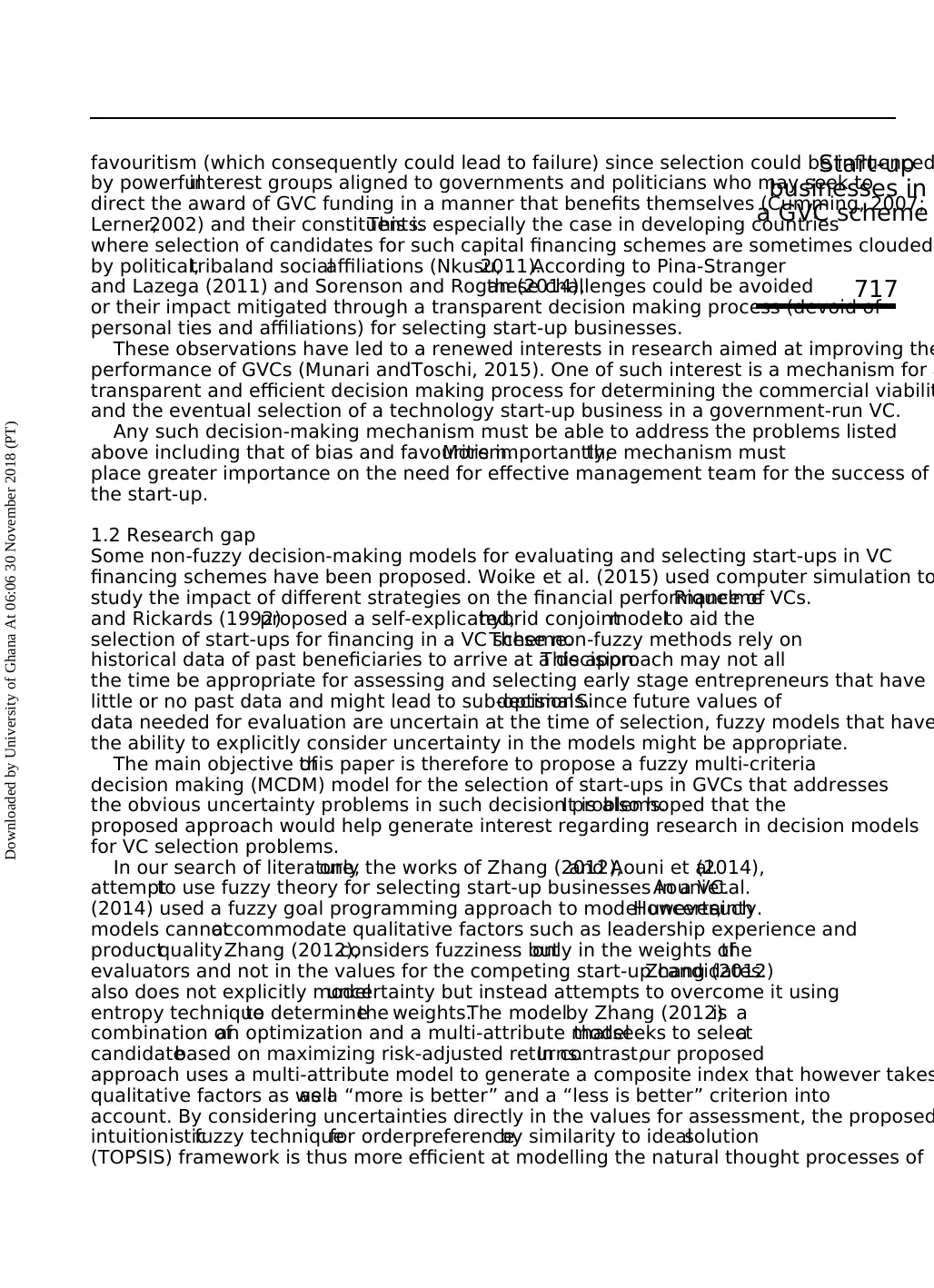
favouritism (which consequently could lead to failure) since selection could be influenced
by powerfulinterest groups aligned to governments and politicians who may seek to
direct the award of GVC funding in a manner that benefits themselves (Cumming, 2007;
Lerner,2002) and their constituents.This is especially the case in developing countries
where selection of candidates for such capital financing schemes are sometimes clouded
by political,tribaland socialaffiliations (Nkusu,2011).According to Pina-Stranger
and Lazega (2011) and Sorenson and Rogan (2014),these challenges could be avoided
or their impact mitigated through a transparent decision making process (devoid of
personal ties and affiliations) for selecting start-up businesses.
These observations have led to a renewed interests in research aimed at improving the
performance of GVCs (Munari andToschi, 2015). One of such interest is a mechanism for a
transparent and efficient decision making process for determining the commercial viabilit
and the eventual selection of a technology start-up business in a government-run VC.
Any such decision-making mechanism must be able to address the problems listed
above including that of bias and favouritism.More importantly,the mechanism must
place greater importance on the need for effective management team for the success of
the start-up.
1.2 Research gap
Some non-fuzzy decision-making models for evaluating and selecting start-ups in VC
financing schemes have been proposed. Woike et al. (2015) used computer simulation to
study the impact of different strategies on the financial performance of VCs.Riquelme
and Rickards (1992)proposed a self-explicated,hybrid conjointmodelto aid the
selection of start-ups for financing in a VC scheme.These non-fuzzy methods rely on
historical data of past beneficiaries to arrive at a decision.This approach may not all
the time be appropriate for assessing and selecting early stage entrepreneurs that have
little or no past data and might lead to sub-optimaldecisions.Since future values of
data needed for evaluation are uncertain at the time of selection, fuzzy models that have
the ability to explicitly consider uncertainty in the models might be appropriate.
The main objective ofthis paper is therefore to propose a fuzzy multi-criteria
decision making (MCDM) model for the selection of start-ups in GVCs that addresses
the obvious uncertainty problems in such decision problems.It is also hoped that the
proposed approach would help generate interest regarding research in decision models
for VC selection problems.
In our search of literature,only the works of Zhang (2012),and Aouni et al.(2014),
attemptto use fuzzy theory for selecting start-up businesses in a VC.Aounietal.
(2014) used a fuzzy goal programming approach to model uncertainty.However,such
models cannotaccommodate qualitative factors such as leadership experience and
productquality.Zhang (2012),considers fuzziness butonly in the weights ofthe
evaluators and not in the values for the competing start-up candidates.Zhang (2012)
also does not explicitly modeluncertainty but instead attempts to overcome it using
entropy techniqueto determinethe weights.The modelby Zhang (2012)is a
combination ofan optimization and a multi-attribute modelthatseeks to selecta
candidatebased on maximizing risk-adjusted returns.In contrast,our proposed
approach uses a multi-attribute model to generate a composite index that however takes
qualitative factors as wellas a “more is better” and a “less is better” criterion into
account. By considering uncertainties directly in the values for assessment, the proposed
intuitionisticfuzzy techniquefor orderpreferenceby similarity to idealsolution
(TOPSIS) framework is thus more efficient at modelling the natural thought processes of
717
Start-up
businesses in
a GVC scheme
Downloaded by University of Ghana At 06:06 30 November 2018 (PT)
by powerfulinterest groups aligned to governments and politicians who may seek to
direct the award of GVC funding in a manner that benefits themselves (Cumming, 2007;
Lerner,2002) and their constituents.This is especially the case in developing countries
where selection of candidates for such capital financing schemes are sometimes clouded
by political,tribaland socialaffiliations (Nkusu,2011).According to Pina-Stranger
and Lazega (2011) and Sorenson and Rogan (2014),these challenges could be avoided
or their impact mitigated through a transparent decision making process (devoid of
personal ties and affiliations) for selecting start-up businesses.
These observations have led to a renewed interests in research aimed at improving the
performance of GVCs (Munari andToschi, 2015). One of such interest is a mechanism for a
transparent and efficient decision making process for determining the commercial viabilit
and the eventual selection of a technology start-up business in a government-run VC.
Any such decision-making mechanism must be able to address the problems listed
above including that of bias and favouritism.More importantly,the mechanism must
place greater importance on the need for effective management team for the success of
the start-up.
1.2 Research gap
Some non-fuzzy decision-making models for evaluating and selecting start-ups in VC
financing schemes have been proposed. Woike et al. (2015) used computer simulation to
study the impact of different strategies on the financial performance of VCs.Riquelme
and Rickards (1992)proposed a self-explicated,hybrid conjointmodelto aid the
selection of start-ups for financing in a VC scheme.These non-fuzzy methods rely on
historical data of past beneficiaries to arrive at a decision.This approach may not all
the time be appropriate for assessing and selecting early stage entrepreneurs that have
little or no past data and might lead to sub-optimaldecisions.Since future values of
data needed for evaluation are uncertain at the time of selection, fuzzy models that have
the ability to explicitly consider uncertainty in the models might be appropriate.
The main objective ofthis paper is therefore to propose a fuzzy multi-criteria
decision making (MCDM) model for the selection of start-ups in GVCs that addresses
the obvious uncertainty problems in such decision problems.It is also hoped that the
proposed approach would help generate interest regarding research in decision models
for VC selection problems.
In our search of literature,only the works of Zhang (2012),and Aouni et al.(2014),
attemptto use fuzzy theory for selecting start-up businesses in a VC.Aounietal.
(2014) used a fuzzy goal programming approach to model uncertainty.However,such
models cannotaccommodate qualitative factors such as leadership experience and
productquality.Zhang (2012),considers fuzziness butonly in the weights ofthe
evaluators and not in the values for the competing start-up candidates.Zhang (2012)
also does not explicitly modeluncertainty but instead attempts to overcome it using
entropy techniqueto determinethe weights.The modelby Zhang (2012)is a
combination ofan optimization and a multi-attribute modelthatseeks to selecta
candidatebased on maximizing risk-adjusted returns.In contrast,our proposed
approach uses a multi-attribute model to generate a composite index that however takes
qualitative factors as wellas a “more is better” and a “less is better” criterion into
account. By considering uncertainties directly in the values for assessment, the proposed
intuitionisticfuzzy techniquefor orderpreferenceby similarity to idealsolution
(TOPSIS) framework is thus more efficient at modelling the natural thought processes of
717
Start-up
businesses in
a GVC scheme
Downloaded by University of Ghana At 06:06 30 November 2018 (PT)
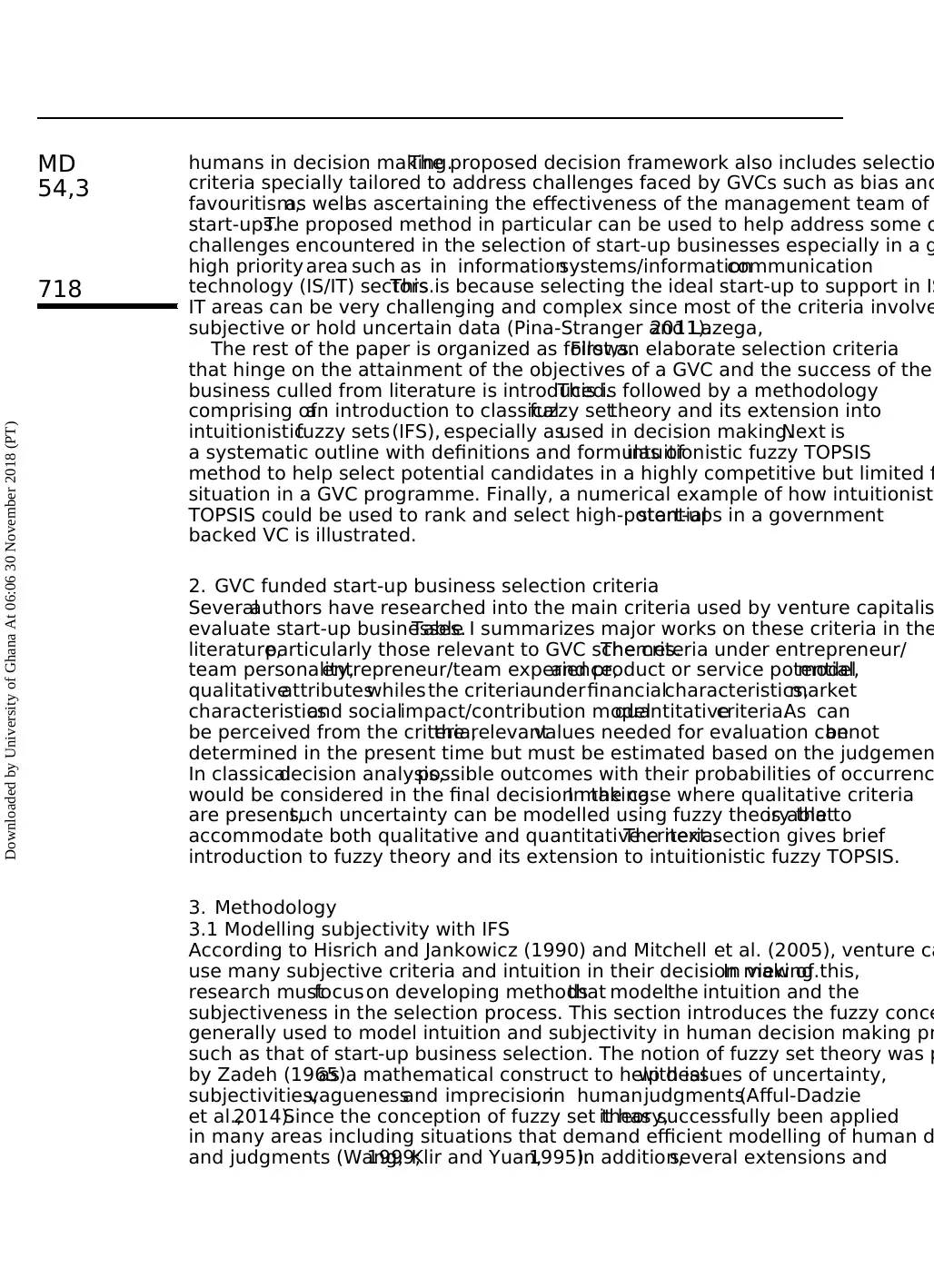
humans in decision making.The proposed decision framework also includes selectio
criteria specially tailored to address challenges faced by GVCs such as bias and
favouritism,as wellas ascertaining the effectiveness of the management team of
start-ups.The proposed method in particular can be used to help address some o
challenges encountered in the selection of start-up businesses especially in a g
high priority area such as in informationsystems/informationcommunication
technology (IS/IT) sectors.This is because selecting the ideal start-up to support in IS
IT areas can be very challenging and complex since most of the criteria involve
subjective or hold uncertain data (Pina-Stranger and Lazega,2011).
The rest of the paper is organized as follows.First,an elaborate selection criteria
that hinge on the attainment of the objectives of a GVC and the success of the
business culled from literature is introduced.This is followed by a methodology
comprising ofan introduction to classicalfuzzy settheory and its extension into
intuitionisticfuzzy sets(IFS), especially asused in decision making.Next is
a systematic outline with definitions and formulas ofintuitionistic fuzzy TOPSIS
method to help select potential candidates in a highly competitive but limited f
situation in a GVC programme. Finally, a numerical example of how intuitionisti
TOPSIS could be used to rank and select high-potentialstart-ups in a government
backed VC is illustrated.
2. GVC funded start-up business selection criteria
Severalauthors have researched into the main criteria used by venture capitalis
evaluate start-up businesses.Table I summarizes major works on these criteria in the
literature,particularly those relevant to GVC schemes.The criteria under entrepreneur/
team personality,entrepreneur/team experience,and product or service potential,model
qualitativeattributeswhiles the criteriaunderfinancialcharacteristics,market
characteristicsand socialimpact/contribution modelquantitativecriteria.As can
be perceived from the criteria,the relevantvalues needed for evaluation cannotbe
determined in the present time but must be estimated based on the judgemen
In classicaldecision analysis,possible outcomes with their probabilities of occurrenc
would be considered in the final decision making.In the case where qualitative criteria
are present,such uncertainty can be modelled using fuzzy theory thatis able to
accommodate both qualitative and quantitative criteria.The next section gives brief
introduction to fuzzy theory and its extension to intuitionistic fuzzy TOPSIS.
3. Methodology
3.1 Modelling subjectivity with IFS
According to Hisrich and Jankowicz (1990) and Mitchell et al. (2005), venture ca
use many subjective criteria and intuition in their decision making.In view of this,
research mustfocuson developing methodsthat modelthe intuition and the
subjectiveness in the selection process. This section introduces the fuzzy conce
generally used to model intuition and subjectivity in human decision making pr
such as that of start-up business selection. The notion of fuzzy set theory was p
by Zadeh (1965)as a mathematical construct to help dealwith issues of uncertainty,
subjectivities,vaguenessand imprecisionin humanjudgments(Afful-Dadzie
et al.,2014).Since the conception of fuzzy set theory,it has successfully been applied
in many areas including situations that demand efficient modelling of human d
and judgments (Wang,1999;Klir and Yuan,1995).In addition,several extensions and
718
MD
54,3
Downloaded by University of Ghana At 06:06 30 November 2018 (PT)
criteria specially tailored to address challenges faced by GVCs such as bias and
favouritism,as wellas ascertaining the effectiveness of the management team of
start-ups.The proposed method in particular can be used to help address some o
challenges encountered in the selection of start-up businesses especially in a g
high priority area such as in informationsystems/informationcommunication
technology (IS/IT) sectors.This is because selecting the ideal start-up to support in IS
IT areas can be very challenging and complex since most of the criteria involve
subjective or hold uncertain data (Pina-Stranger and Lazega,2011).
The rest of the paper is organized as follows.First,an elaborate selection criteria
that hinge on the attainment of the objectives of a GVC and the success of the
business culled from literature is introduced.This is followed by a methodology
comprising ofan introduction to classicalfuzzy settheory and its extension into
intuitionisticfuzzy sets(IFS), especially asused in decision making.Next is
a systematic outline with definitions and formulas ofintuitionistic fuzzy TOPSIS
method to help select potential candidates in a highly competitive but limited f
situation in a GVC programme. Finally, a numerical example of how intuitionisti
TOPSIS could be used to rank and select high-potentialstart-ups in a government
backed VC is illustrated.
2. GVC funded start-up business selection criteria
Severalauthors have researched into the main criteria used by venture capitalis
evaluate start-up businesses.Table I summarizes major works on these criteria in the
literature,particularly those relevant to GVC schemes.The criteria under entrepreneur/
team personality,entrepreneur/team experience,and product or service potential,model
qualitativeattributeswhiles the criteriaunderfinancialcharacteristics,market
characteristicsand socialimpact/contribution modelquantitativecriteria.As can
be perceived from the criteria,the relevantvalues needed for evaluation cannotbe
determined in the present time but must be estimated based on the judgemen
In classicaldecision analysis,possible outcomes with their probabilities of occurrenc
would be considered in the final decision making.In the case where qualitative criteria
are present,such uncertainty can be modelled using fuzzy theory thatis able to
accommodate both qualitative and quantitative criteria.The next section gives brief
introduction to fuzzy theory and its extension to intuitionistic fuzzy TOPSIS.
3. Methodology
3.1 Modelling subjectivity with IFS
According to Hisrich and Jankowicz (1990) and Mitchell et al. (2005), venture ca
use many subjective criteria and intuition in their decision making.In view of this,
research mustfocuson developing methodsthat modelthe intuition and the
subjectiveness in the selection process. This section introduces the fuzzy conce
generally used to model intuition and subjectivity in human decision making pr
such as that of start-up business selection. The notion of fuzzy set theory was p
by Zadeh (1965)as a mathematical construct to help dealwith issues of uncertainty,
subjectivities,vaguenessand imprecisionin humanjudgments(Afful-Dadzie
et al.,2014).Since the conception of fuzzy set theory,it has successfully been applied
in many areas including situations that demand efficient modelling of human d
and judgments (Wang,1999;Klir and Yuan,1995).In addition,several extensions and
718
MD
54,3
Downloaded by University of Ghana At 06:06 30 November 2018 (PT)
⊘ This is a preview!⊘
Do you want full access?
Subscribe today to unlock all pages.

Trusted by 1+ million students worldwide
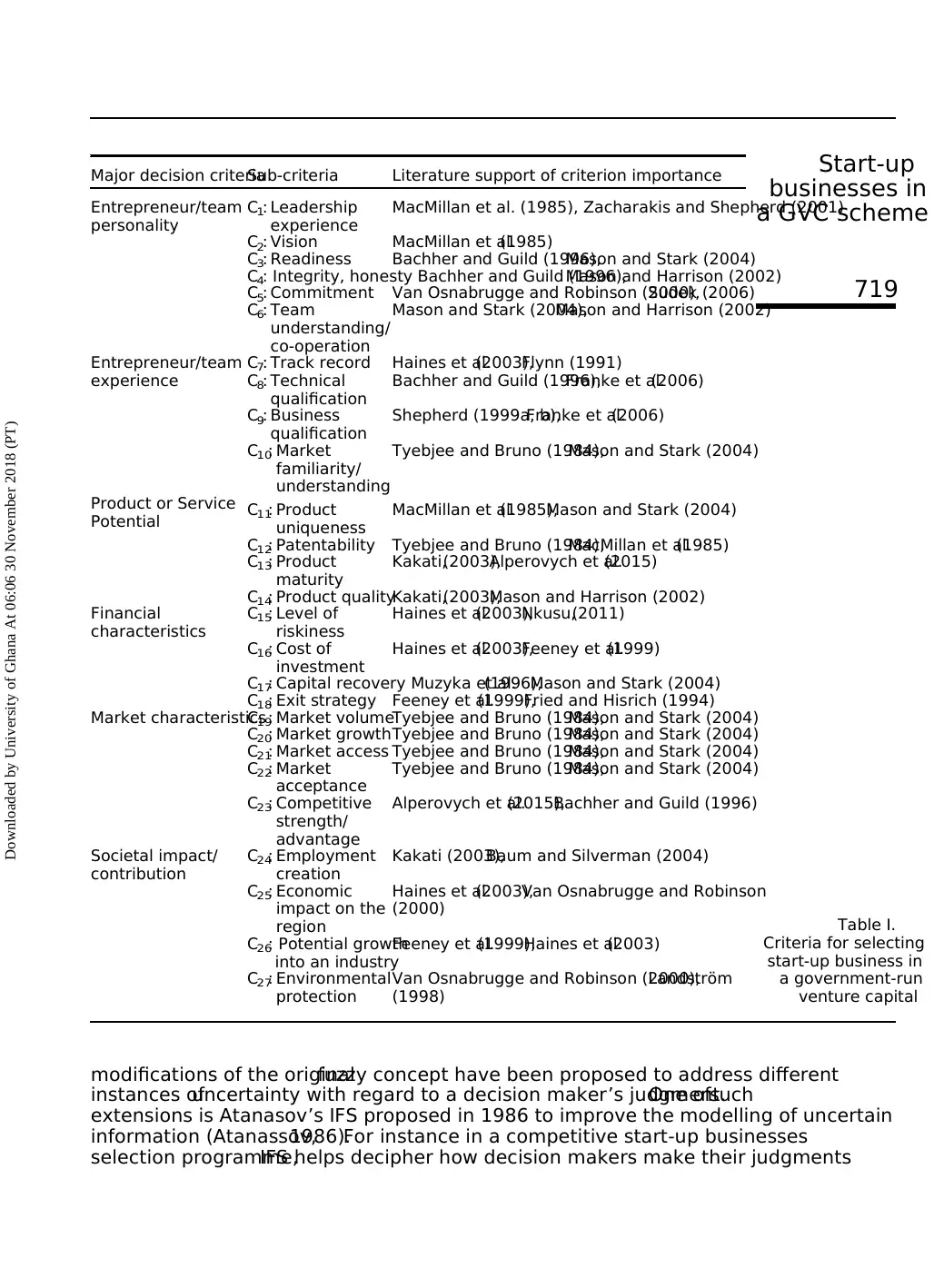
modifications of the originalfuzzy concept have been proposed to address different
instances ofuncertainty with regard to a decision maker’s judgment.One ofsuch
extensions is Atanasov’s IFS proposed in 1986 to improve the modelling of uncertain
information (Atanassov,1986).For instance in a competitive start-up businesses
selection programme,IFS helps decipher how decision makers make their judgments
Major decision criteriaSub-criteria Literature support of criterion importance
Entrepreneur/team
personality
C1: Leadership
experience
MacMillan et al. (1985), Zacharakis and Shepherd (2001)
C2: Vision MacMillan et al.(1985)
C3: Readiness Bachher and Guild (1996),Mason and Stark (2004)
C4: Integrity, honesty Bachher and Guild (1996),Mason and Harrison (2002)
C5: Commitment Van Osnabrugge and Robinson (2000),Sudek (2006)
C6: Team
understanding/
co-operation
Mason and Stark (2004),Mason and Harrison (2002)
Entrepreneur/team
experience
C7: Track record Haines et al.(2003),Flynn (1991)
C8: Technical
qualification
Bachher and Guild (1996),Franke et al.(2006)
C9: Business
qualification
Shepherd (1999a, b),Franke et al.(2006)
C10: Market
familiarity/
understanding
Tyebjee and Bruno (1984),Mason and Stark (2004)
Product or Service
Potential C11: Product
uniqueness
MacMillan et al.(1985),Mason and Stark (2004)
C12: Patentability Tyebjee and Bruno (1984),MacMillan et al.(1985)
C13: Product
maturity
Kakati,(2003),Alperovych et al.(2015)
C14: Product qualityKakati,(2003),Mason and Harrison (2002)
Financial
characteristics
C15: Level of
riskiness
Haines et al.(2003),Nkusu,(2011)
C16: Cost of
investment
Haines et al.(2003),Feeney et al.(1999)
C17: Capital recovery Muzyka et al.(1996),Mason and Stark (2004)
C18: Exit strategy Feeney et al.(1999),Fried and Hisrich (1994)
Market characteristicsC19: Market volumeTyebjee and Bruno (1984),Mason and Stark (2004)
C20: Market growthTyebjee and Bruno (1984),Mason and Stark (2004)
C21: Market access Tyebjee and Bruno (1984),Mason and Stark (2004)
C22: Market
acceptance
Tyebjee and Bruno (1984),Mason and Stark (2004)
C23: Competitive
strength/
advantage
Alperovych et al.(2015),Bachher and Guild (1996)
Societal impact/
contribution
C24: Employment
creation
Kakati (2003),Baum and Silverman (2004)
C25: Economic
impact on the
region
Haines et al.(2003),Van Osnabrugge and Robinson
(2000)
C26: Potential growth
into an industry
Feeney et al.(1999),Haines et al.(2003)
C27: Environmental
protection
Van Osnabrugge and Robinson (2000),Landström
(1998)
Table I.
Criteria for selecting
start-up business in
a government-run
venture capital
719
Start-up
businesses in
a GVC scheme
Downloaded by University of Ghana At 06:06 30 November 2018 (PT)
instances ofuncertainty with regard to a decision maker’s judgment.One ofsuch
extensions is Atanasov’s IFS proposed in 1986 to improve the modelling of uncertain
information (Atanassov,1986).For instance in a competitive start-up businesses
selection programme,IFS helps decipher how decision makers make their judgments
Major decision criteriaSub-criteria Literature support of criterion importance
Entrepreneur/team
personality
C1: Leadership
experience
MacMillan et al. (1985), Zacharakis and Shepherd (2001)
C2: Vision MacMillan et al.(1985)
C3: Readiness Bachher and Guild (1996),Mason and Stark (2004)
C4: Integrity, honesty Bachher and Guild (1996),Mason and Harrison (2002)
C5: Commitment Van Osnabrugge and Robinson (2000),Sudek (2006)
C6: Team
understanding/
co-operation
Mason and Stark (2004),Mason and Harrison (2002)
Entrepreneur/team
experience
C7: Track record Haines et al.(2003),Flynn (1991)
C8: Technical
qualification
Bachher and Guild (1996),Franke et al.(2006)
C9: Business
qualification
Shepherd (1999a, b),Franke et al.(2006)
C10: Market
familiarity/
understanding
Tyebjee and Bruno (1984),Mason and Stark (2004)
Product or Service
Potential C11: Product
uniqueness
MacMillan et al.(1985),Mason and Stark (2004)
C12: Patentability Tyebjee and Bruno (1984),MacMillan et al.(1985)
C13: Product
maturity
Kakati,(2003),Alperovych et al.(2015)
C14: Product qualityKakati,(2003),Mason and Harrison (2002)
Financial
characteristics
C15: Level of
riskiness
Haines et al.(2003),Nkusu,(2011)
C16: Cost of
investment
Haines et al.(2003),Feeney et al.(1999)
C17: Capital recovery Muzyka et al.(1996),Mason and Stark (2004)
C18: Exit strategy Feeney et al.(1999),Fried and Hisrich (1994)
Market characteristicsC19: Market volumeTyebjee and Bruno (1984),Mason and Stark (2004)
C20: Market growthTyebjee and Bruno (1984),Mason and Stark (2004)
C21: Market access Tyebjee and Bruno (1984),Mason and Stark (2004)
C22: Market
acceptance
Tyebjee and Bruno (1984),Mason and Stark (2004)
C23: Competitive
strength/
advantage
Alperovych et al.(2015),Bachher and Guild (1996)
Societal impact/
contribution
C24: Employment
creation
Kakati (2003),Baum and Silverman (2004)
C25: Economic
impact on the
region
Haines et al.(2003),Van Osnabrugge and Robinson
(2000)
C26: Potential growth
into an industry
Feeney et al.(1999),Haines et al.(2003)
C27: Environmental
protection
Van Osnabrugge and Robinson (2000),Landström
(1998)
Table I.
Criteria for selecting
start-up business in
a government-run
venture capital
719
Start-up
businesses in
a GVC scheme
Downloaded by University of Ghana At 06:06 30 November 2018 (PT)
Paraphrase This Document
Need a fresh take? Get an instant paraphrase of this document with our AI Paraphraser
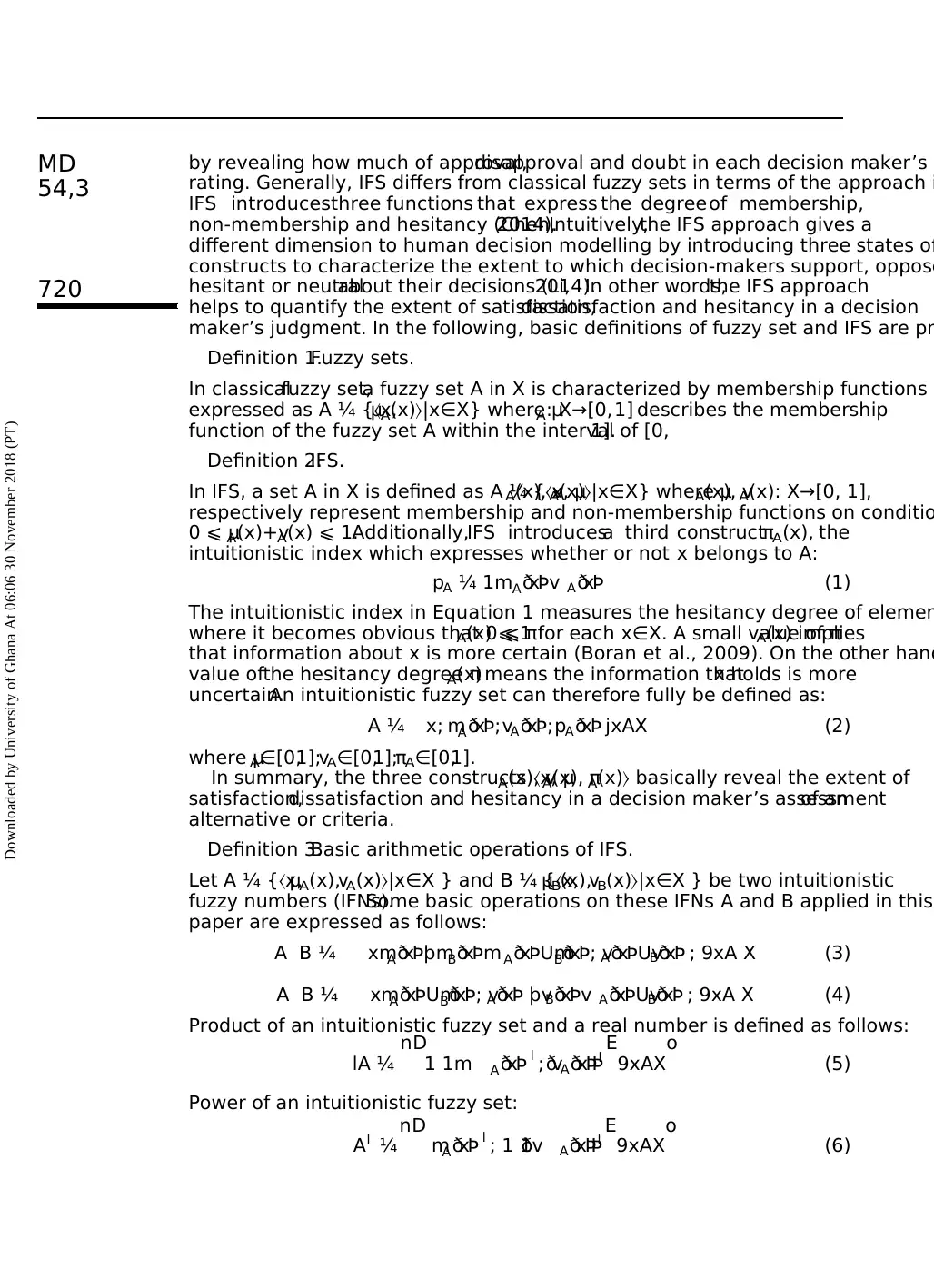
by revealing how much of approval,disapproval and doubt in each decision maker’s
rating. Generally, IFS differs from classical fuzzy sets in terms of the approach i
IFS introducesthree functions that express the degreeof membership,
non-membership and hesitancy (Chen,2014).Intuitively,the IFS approach gives a
different dimension to human decision modelling by introducing three states of
constructs to characterize the extent to which decision-makers support, oppose
hesitant or neutralabout their decisions (Li,2014).In other words,the IFS approach
helps to quantify the extent of satisfaction,dissatisfaction and hesitancy in a decision
maker’s judgment. In the following, basic definitions of fuzzy set and IFS are pr
Definition 1.Fuzzy sets.
In classicalfuzzy set,a fuzzy set A in X is characterized by membership functions
expressed as A ¼ {〈x,μA(x)〉|x∈X} where μA: X→[0,1] describes the membership
function of the fuzzy set A within the interval of [0,1].
Definition 2.IFS.
In IFS, a set A in X is defined as A ¼ {〈x, μA(x), vA(x)〉|x∈X} where μA(x), vA(x): X→[0, 1],
respectively represent membership and non-membership functions on conditio
0 ⩽ μA(x)+vA(x) ⩽ 1.Additionally,IFS introducesa third constructπA(x), the
intuitionistic index which expresses whether or not x belongs to A:
pA ¼ 1mA xð Þv A xð Þ (1)
The intuitionistic index in Equation 1 measures the hesitancy degree of elemen
where it becomes obvious that 0 ⩽ πA(x) ⩽ 1 for each x∈X. A small value of πA(x) implies
that information about x is more certain (Boran et al., 2009). On the other hand
value ofthe hesitancy degree πA(x) means the information thatx holds is more
uncertain.An intuitionistic fuzzy set can therefore fully be defined as:
A ¼ x; mA xð Þ;vA xð Þ;pA xð Þ xAXj (2)
where μA∈[0,1];vA∈[0,1];πA∈[0,1].
In summary, the three constructs 〈x, μA(x), vA(x), πA(x)〉 basically reveal the extent of
satisfaction,dissatisfaction and hesitancy in a decision maker’s assessmentof an
alternative or criteria.
Definition 3.Basic arithmetic operations of IFS.
Let A ¼ {〈x,μA(x),vA(x)〉|x∈X } and B ¼ {〈x,μB(x),vB(x)〉|x∈X } be two intuitionistic
fuzzy numbers (IFNs).Some basic operations on these IFNs A and B applied in this
paper are expressed as follows:
A B ¼ xmA xð ÞþmB xð Þm A xð ÞUmB xð Þ; vA xð ÞUvB xð Þ ; 9xA X (3)
A B ¼ xmA xð ÞUmB xð Þ; vA xð Þ þvB xð Þv A xð ÞUvB xð Þ ; 9xA X (4)
Product of an intuitionistic fuzzy set and a real number is defined as follows:
lA ¼ 1 1m A xð Þ l ; vA xð Þð Þl
D E
9xAX
n o
(5)
Power of an intuitionistic fuzzy set:
Al ¼ mA xð Þ l ; 1 1v A xð Þð Þl
D E
9xAX
n o
(6)
720
MD
54,3
Downloaded by University of Ghana At 06:06 30 November 2018 (PT)
rating. Generally, IFS differs from classical fuzzy sets in terms of the approach i
IFS introducesthree functions that express the degreeof membership,
non-membership and hesitancy (Chen,2014).Intuitively,the IFS approach gives a
different dimension to human decision modelling by introducing three states of
constructs to characterize the extent to which decision-makers support, oppose
hesitant or neutralabout their decisions (Li,2014).In other words,the IFS approach
helps to quantify the extent of satisfaction,dissatisfaction and hesitancy in a decision
maker’s judgment. In the following, basic definitions of fuzzy set and IFS are pr
Definition 1.Fuzzy sets.
In classicalfuzzy set,a fuzzy set A in X is characterized by membership functions
expressed as A ¼ {〈x,μA(x)〉|x∈X} where μA: X→[0,1] describes the membership
function of the fuzzy set A within the interval of [0,1].
Definition 2.IFS.
In IFS, a set A in X is defined as A ¼ {〈x, μA(x), vA(x)〉|x∈X} where μA(x), vA(x): X→[0, 1],
respectively represent membership and non-membership functions on conditio
0 ⩽ μA(x)+vA(x) ⩽ 1.Additionally,IFS introducesa third constructπA(x), the
intuitionistic index which expresses whether or not x belongs to A:
pA ¼ 1mA xð Þv A xð Þ (1)
The intuitionistic index in Equation 1 measures the hesitancy degree of elemen
where it becomes obvious that 0 ⩽ πA(x) ⩽ 1 for each x∈X. A small value of πA(x) implies
that information about x is more certain (Boran et al., 2009). On the other hand
value ofthe hesitancy degree πA(x) means the information thatx holds is more
uncertain.An intuitionistic fuzzy set can therefore fully be defined as:
A ¼ x; mA xð Þ;vA xð Þ;pA xð Þ xAXj (2)
where μA∈[0,1];vA∈[0,1];πA∈[0,1].
In summary, the three constructs 〈x, μA(x), vA(x), πA(x)〉 basically reveal the extent of
satisfaction,dissatisfaction and hesitancy in a decision maker’s assessmentof an
alternative or criteria.
Definition 3.Basic arithmetic operations of IFS.
Let A ¼ {〈x,μA(x),vA(x)〉|x∈X } and B ¼ {〈x,μB(x),vB(x)〉|x∈X } be two intuitionistic
fuzzy numbers (IFNs).Some basic operations on these IFNs A and B applied in this
paper are expressed as follows:
A B ¼ xmA xð ÞþmB xð Þm A xð ÞUmB xð Þ; vA xð ÞUvB xð Þ ; 9xA X (3)
A B ¼ xmA xð ÞUmB xð Þ; vA xð Þ þvB xð Þv A xð ÞUvB xð Þ ; 9xA X (4)
Product of an intuitionistic fuzzy set and a real number is defined as follows:
lA ¼ 1 1m A xð Þ l ; vA xð Þð Þl
D E
9xAX
n o
(5)
Power of an intuitionistic fuzzy set:
Al ¼ mA xð Þ l ; 1 1v A xð Þð Þl
D E
9xAX
n o
(6)
720
MD
54,3
Downloaded by University of Ghana At 06:06 30 November 2018 (PT)
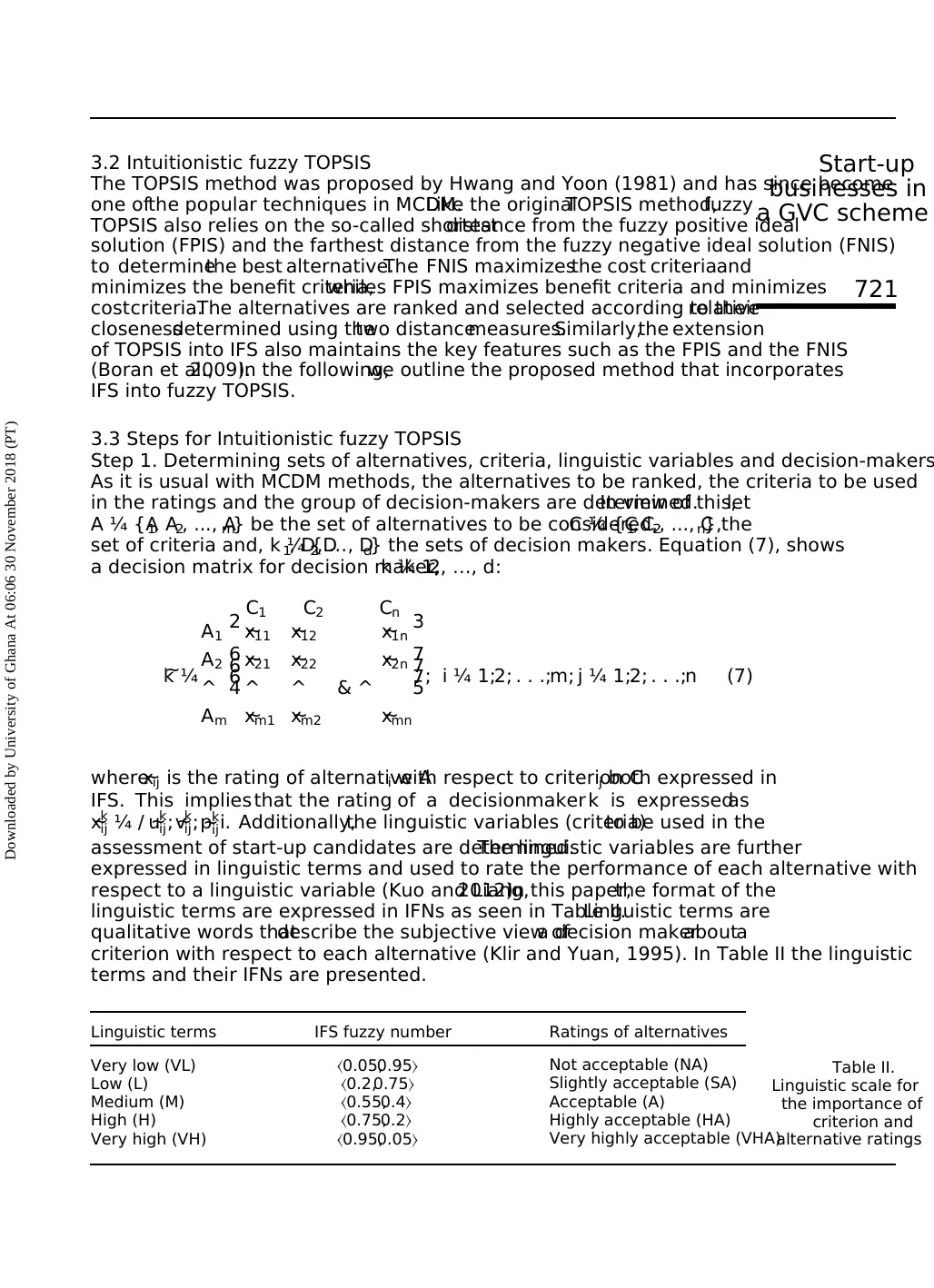
3.2 Intuitionistic fuzzy TOPSIS
The TOPSIS method was proposed by Hwang and Yoon (1981) and has since become
one ofthe popular techniques in MCDM.Like the originalTOPSIS method,fuzzy
TOPSIS also relies on the so-called shortestdistance from the fuzzy positive ideal
solution (FPIS) and the farthest distance from the fuzzy negative ideal solution (FNIS)
to determinethe best alternative.The FNIS maximizesthe cost criteriaand
minimizes the benefit criteria,whiles FPIS maximizes benefit criteria and minimizes
costcriteria.The alternatives are ranked and selected according to theirrelative
closenessdetermined using thetwo distancemeasures.Similarly,the extension
of TOPSIS into IFS also maintains the key features such as the FPIS and the FNIS
(Boran et al.,2009).In the following,we outline the proposed method that incorporates
IFS into fuzzy TOPSIS.
3.3 Steps for Intuitionistic fuzzy TOPSIS
Step 1. Determining sets of alternatives, criteria, linguistic variables and decision-makers
As it is usual with MCDM methods, the alternatives to be ranked, the criteria to be used
in the ratings and the group of decision-makers are determined.In view of this,let
A ¼ {A1, A2, ..., Am} be the set of alternatives to be considered,C ¼ {C1, C2, ..., Cn},the
set of criteria and, k ¼ {D1, D2, …, Dd} the sets of decision makers. Equation (7), shows
a decision matrix for decision maker,k ¼ 1,2, …, d:
C1 C2 Cn
~k ¼
A1
A2
^
Am
~x11 ~x12 ~x1n
~x21 ~x22 ~x2n
^ ^ & ^
~xm1 ~xm2 ~xmn
2
6
6
6
4
3
7
7
7
5; i ¼ 1;2; . . .;m; j ¼ 1;2; . . .;n (7)
where~xij is the rating of alternative Ai with respect to criterion Cj both expressed in
IFS. This implies that the rating of a decisionmaker k is expressedas
~xk
ij ¼ / ~uk
ij; ~vk
ij; ~pk
iji. Additionally,the linguistic variables (criteria)to be used in the
assessment of start-up candidates are determined.The linguistic variables are further
expressed in linguistic terms and used to rate the performance of each alternative with
respect to a linguistic variable (Kuo and Liang,2012).In this paper,the format of the
linguistic terms are expressed in IFNs as seen in Table II.Linguistic terms are
qualitative words thatdescribe the subjective view ofa decision makerabouta
criterion with respect to each alternative (Klir and Yuan, 1995). In Table II the linguistic
terms and their IFNs are presented.
Linguistic terms IFS fuzzy number Ratings of alternatives
Very low (VL) 〈0.05,0.95〉 Not acceptable (NA)
Low (L) 〈0.2,0.75〉 Slightly acceptable (SA)
Medium (M) 〈0.55,0.4〉 Acceptable (A)
High (H) 〈0.75,0.2〉 Highly acceptable (HA)
Very high (VH) 〈0.95,0.05〉 Very highly acceptable (VHA)
Table II.
Linguistic scale for
the importance of
criterion and
alternative ratings
721
Start-up
businesses in
a GVC scheme
Downloaded by University of Ghana At 06:06 30 November 2018 (PT)
The TOPSIS method was proposed by Hwang and Yoon (1981) and has since become
one ofthe popular techniques in MCDM.Like the originalTOPSIS method,fuzzy
TOPSIS also relies on the so-called shortestdistance from the fuzzy positive ideal
solution (FPIS) and the farthest distance from the fuzzy negative ideal solution (FNIS)
to determinethe best alternative.The FNIS maximizesthe cost criteriaand
minimizes the benefit criteria,whiles FPIS maximizes benefit criteria and minimizes
costcriteria.The alternatives are ranked and selected according to theirrelative
closenessdetermined using thetwo distancemeasures.Similarly,the extension
of TOPSIS into IFS also maintains the key features such as the FPIS and the FNIS
(Boran et al.,2009).In the following,we outline the proposed method that incorporates
IFS into fuzzy TOPSIS.
3.3 Steps for Intuitionistic fuzzy TOPSIS
Step 1. Determining sets of alternatives, criteria, linguistic variables and decision-makers
As it is usual with MCDM methods, the alternatives to be ranked, the criteria to be used
in the ratings and the group of decision-makers are determined.In view of this,let
A ¼ {A1, A2, ..., Am} be the set of alternatives to be considered,C ¼ {C1, C2, ..., Cn},the
set of criteria and, k ¼ {D1, D2, …, Dd} the sets of decision makers. Equation (7), shows
a decision matrix for decision maker,k ¼ 1,2, …, d:
C1 C2 Cn
~k ¼
A1
A2
^
Am
~x11 ~x12 ~x1n
~x21 ~x22 ~x2n
^ ^ & ^
~xm1 ~xm2 ~xmn
2
6
6
6
4
3
7
7
7
5; i ¼ 1;2; . . .;m; j ¼ 1;2; . . .;n (7)
where~xij is the rating of alternative Ai with respect to criterion Cj both expressed in
IFS. This implies that the rating of a decisionmaker k is expressedas
~xk
ij ¼ / ~uk
ij; ~vk
ij; ~pk
iji. Additionally,the linguistic variables (criteria)to be used in the
assessment of start-up candidates are determined.The linguistic variables are further
expressed in linguistic terms and used to rate the performance of each alternative with
respect to a linguistic variable (Kuo and Liang,2012).In this paper,the format of the
linguistic terms are expressed in IFNs as seen in Table II.Linguistic terms are
qualitative words thatdescribe the subjective view ofa decision makerabouta
criterion with respect to each alternative (Klir and Yuan, 1995). In Table II the linguistic
terms and their IFNs are presented.
Linguistic terms IFS fuzzy number Ratings of alternatives
Very low (VL) 〈0.05,0.95〉 Not acceptable (NA)
Low (L) 〈0.2,0.75〉 Slightly acceptable (SA)
Medium (M) 〈0.55,0.4〉 Acceptable (A)
High (H) 〈0.75,0.2〉 Highly acceptable (HA)
Very high (VH) 〈0.95,0.05〉 Very highly acceptable (VHA)
Table II.
Linguistic scale for
the importance of
criterion and
alternative ratings
721
Start-up
businesses in
a GVC scheme
Downloaded by University of Ghana At 06:06 30 November 2018 (PT)
⊘ This is a preview!⊘
Do you want full access?
Subscribe today to unlock all pages.

Trusted by 1+ million students worldwide
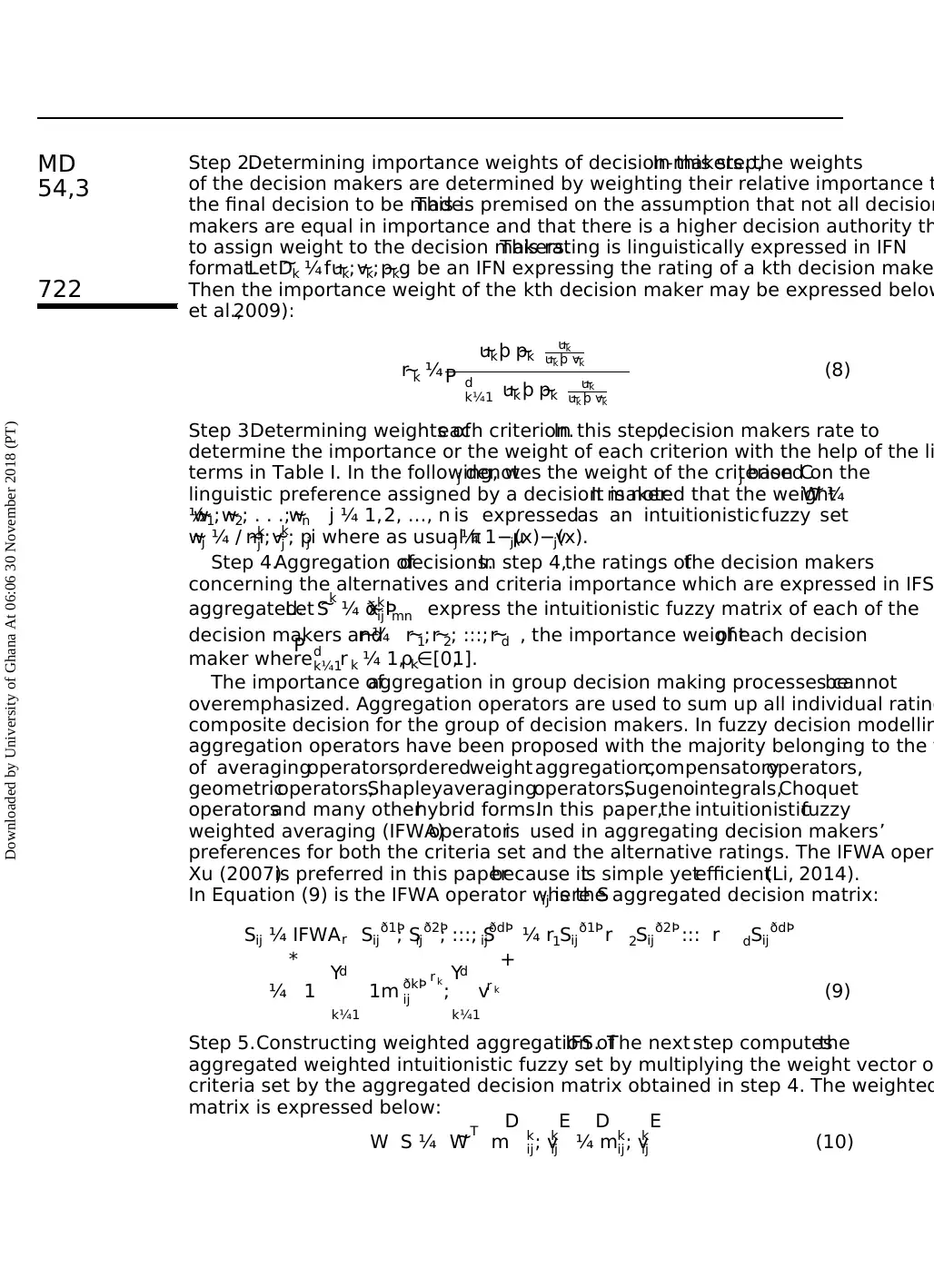
Step 2.Determining importance weights of decision-makers.In this step,the weights
of the decision makers are determined by weighting their relative importance t
the final decision to be made.This is premised on the assumption that not all decision
makers are equal in importance and that there is a higher decision authority th
to assign weight to the decision makers.This rating is linguistically expressed in IFN
format.Let ~Dk ¼ ~uk; ~vk; ~pkf g be an IFN expressing the rating of a kth decision make
Then the importance weight of the kth decision maker may be expressed below
et al.,2009):
~r k ¼
~ukþ ~pk ~uk
~uk þ ~vk
P d
k¼1 ~uk þ ~pk ~uk
~uk þ ~vk
(8)
Step 3.Determining weights ofeach criterion.In this step,decision makers rate to
determine the importance or the weight of each criterion with the help of the li
terms in Table I. In the following, wj denotes the weight of the criterion Cj based on the
linguistic preference assigned by a decision maker.It is noted that the weight~W ¼
~w1; ~w2; . . .;~wn½ j ¼ 1,2, …, n is expressedas an intuitionisticfuzzy set
~wj ¼ / ~mk
j ; ~vk
j ; pji where as usual πj ¼ 1−μj(x)−vj(x).
Step 4.Aggregation ofdecisions.In step 4,the ratings ofthe decision makers
concerning the alternatives and criteria importance which are expressed in IFS
aggregated.Let ~Sk ¼ ð~xk
ijÞmn express the intuitionistic fuzzy matrix of each of the
decision makers and~r ¼ ~r 1; ~r 2; :::; ~r d , the importance weightof each decision
maker where
P d
k¼1r k ¼ 1,ρk∈[0,1].
The importance ofaggregation in group decision making processes cannotbe
overemphasized. Aggregation operators are used to sum up all individual rating
composite decision for the group of decision makers. In fuzzy decision modellin
aggregation operators have been proposed with the majority belonging to the f
of averagingoperators,orderedweight aggregation,compensatoryoperators,
geometricoperators,Shapleyaveragingoperators,Sugenointegrals,Choquet
operatorsand many otherhybrid forms.In this paper,the intuitionisticfuzzy
weighted averaging (IFWA)operatoris used in aggregating decision makers’
preferences for both the criteria set and the alternative ratings. The IFWA opera
Xu (2007)is preferred in this paperbecause itis simple yetefficient(Li, 2014).
In Equation (9) is the IFWA operator where Sij is the aggregated decision matrix:
Sij ¼ IFWAr Sijð1Þ
; Sijð2Þ
; :::; SijðdÞ ¼ r1Sijð1Þ r 2Sijð2Þ ::: r dSijðdÞ
¼ 1 Yd
k¼1
1m ðkÞ
ij
r k
;Yd
k¼1
vr k
* +
(9)
Step 5.Constructing weighted aggregation ofIFS. The next step computesthe
aggregated weighted intuitionistic fuzzy set by multiplying the weight vector o
criteria set by the aggregated decision matrix obtained in step 4. The weighted
matrix is expressed below:
W S ¼ ~W T m k
ij; vk
ij
D E
¼ mk
ij; vk
ij
D E
(10)
722
MD
54,3
Downloaded by University of Ghana At 06:06 30 November 2018 (PT)
of the decision makers are determined by weighting their relative importance t
the final decision to be made.This is premised on the assumption that not all decision
makers are equal in importance and that there is a higher decision authority th
to assign weight to the decision makers.This rating is linguistically expressed in IFN
format.Let ~Dk ¼ ~uk; ~vk; ~pkf g be an IFN expressing the rating of a kth decision make
Then the importance weight of the kth decision maker may be expressed below
et al.,2009):
~r k ¼
~ukþ ~pk ~uk
~uk þ ~vk
P d
k¼1 ~uk þ ~pk ~uk
~uk þ ~vk
(8)
Step 3.Determining weights ofeach criterion.In this step,decision makers rate to
determine the importance or the weight of each criterion with the help of the li
terms in Table I. In the following, wj denotes the weight of the criterion Cj based on the
linguistic preference assigned by a decision maker.It is noted that the weight~W ¼
~w1; ~w2; . . .;~wn½ j ¼ 1,2, …, n is expressedas an intuitionisticfuzzy set
~wj ¼ / ~mk
j ; ~vk
j ; pji where as usual πj ¼ 1−μj(x)−vj(x).
Step 4.Aggregation ofdecisions.In step 4,the ratings ofthe decision makers
concerning the alternatives and criteria importance which are expressed in IFS
aggregated.Let ~Sk ¼ ð~xk
ijÞmn express the intuitionistic fuzzy matrix of each of the
decision makers and~r ¼ ~r 1; ~r 2; :::; ~r d , the importance weightof each decision
maker where
P d
k¼1r k ¼ 1,ρk∈[0,1].
The importance ofaggregation in group decision making processes cannotbe
overemphasized. Aggregation operators are used to sum up all individual rating
composite decision for the group of decision makers. In fuzzy decision modellin
aggregation operators have been proposed with the majority belonging to the f
of averagingoperators,orderedweight aggregation,compensatoryoperators,
geometricoperators,Shapleyaveragingoperators,Sugenointegrals,Choquet
operatorsand many otherhybrid forms.In this paper,the intuitionisticfuzzy
weighted averaging (IFWA)operatoris used in aggregating decision makers’
preferences for both the criteria set and the alternative ratings. The IFWA opera
Xu (2007)is preferred in this paperbecause itis simple yetefficient(Li, 2014).
In Equation (9) is the IFWA operator where Sij is the aggregated decision matrix:
Sij ¼ IFWAr Sijð1Þ
; Sijð2Þ
; :::; SijðdÞ ¼ r1Sijð1Þ r 2Sijð2Þ ::: r dSijðdÞ
¼ 1 Yd
k¼1
1m ðkÞ
ij
r k
;Yd
k¼1
vr k
* +
(9)
Step 5.Constructing weighted aggregation ofIFS. The next step computesthe
aggregated weighted intuitionistic fuzzy set by multiplying the weight vector o
criteria set by the aggregated decision matrix obtained in step 4. The weighted
matrix is expressed below:
W S ¼ ~W T m k
ij; vk
ij
D E
¼ mk
ij; vk
ij
D E
(10)
722
MD
54,3
Downloaded by University of Ghana At 06:06 30 November 2018 (PT)
Paraphrase This Document
Need a fresh take? Get an instant paraphrase of this document with our AI Paraphraser
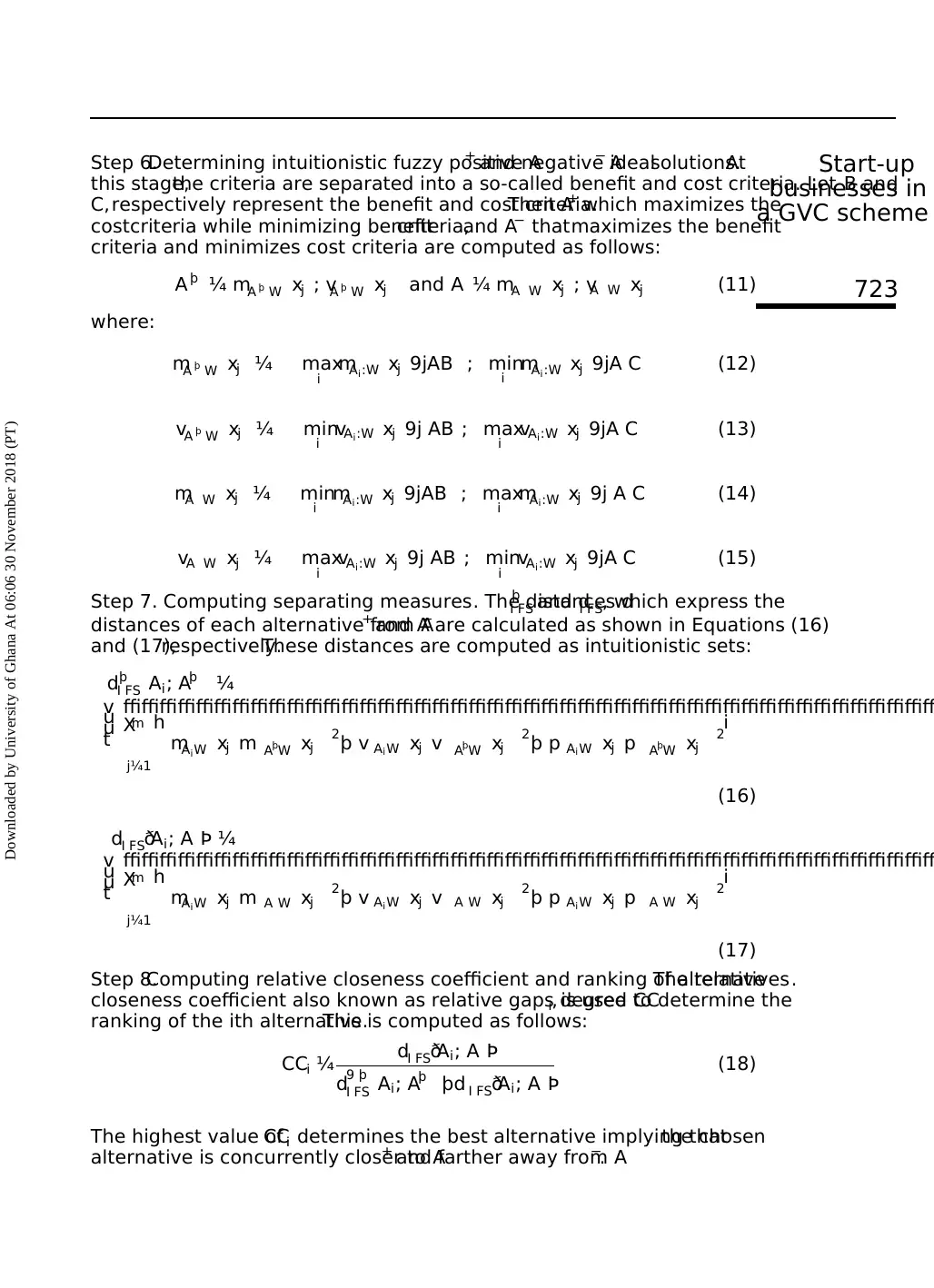
Step 6.Determining intuitionistic fuzzy positive A+ and negative A− idealsolutions.At
this stage,the criteria are separated into a so-called benefit and cost criteria. Let B and
C,respectively represent the benefit and cost criteria.Then A+ which maximizes the
costcriteria while minimizing benefitcriteria,and A− thatmaximizes the benefit
criteria and minimizes cost criteria are computed as follows:
A þ ¼ mA þ W xj ; vA þ W xj and A ¼ mA W xj ; vA W xj (11)
where:
mA þ W xj ¼ max
i mAi :W xj 9jAB ; min
i mAi :W xj 9jA C (12)
vA þ W xj ¼ min
i vAi:W xj 9j AB ; max
i vAi :W xj 9jA C (13)
mA W xj ¼ min
i mAi:W xj 9jAB ; max
i
mAi:W xj 9j A C (14)
vA W xj ¼ max
i vAi:W xj 9j AB ; min
i vAi:W xj 9jA C (15)
Step 7. Computing separating measures. The distances dþ
I FS and dI FS, which express the
distances of each alternative from A+ and A− are calculated as shown in Equations (16)
and (17),respectively.These distances are computed as intuitionistic sets:
dþ
I FS Ai; Aþ ¼
ffiffiffiffiffiffiffiffiffiffiffiffiffiffiffiffiffiffiffiffiffiffiffiffiffiffiffiffiffiffiffiffiffiffiffiffiffiffiffiffiffiffiffiffiffi
Xm
j¼1
mAiW xj m AþW xj
2þ v Ai W xj v AþW xj
2þ p Ai W xj p AþW xj
2
h i
v
u
u
t
(16)
dI FS Ai; Að Þ ¼
ffiffiffiffiffiffiffiffiffiffiffiffiffiffiffiffiffiffiffiffiffiffiffiffiffiffiffiffiffiffiffiffiffiffiffiffiffiffiffiffiffiffiffiffiffi
Xm
j¼1
mAiW xj m A W xj
2þ v Ai W xj v A W xj
2þ p Ai W xj p A W xj
2
h i
v
u
u
t
(17)
Step 8.Computing relative closeness coefficient and ranking of alternatives.The relative
closeness coefficient also known as relative gaps degree CCi, is used to determine the
ranking of the ith alternative.This is computed as follows:
CCi ¼ dI FS Ai; Að Þ
d9 þ
I FS Ai; Aþ þd I FS Ai; Að Þ
(18)
The highest value ofCCi determines the best alternative implying thatthe chosen
alternative is concurrently closer to A+ and farther away from A−.
723
Start-up
businesses in
a GVC scheme
Downloaded by University of Ghana At 06:06 30 November 2018 (PT)
this stage,the criteria are separated into a so-called benefit and cost criteria. Let B and
C,respectively represent the benefit and cost criteria.Then A+ which maximizes the
costcriteria while minimizing benefitcriteria,and A− thatmaximizes the benefit
criteria and minimizes cost criteria are computed as follows:
A þ ¼ mA þ W xj ; vA þ W xj and A ¼ mA W xj ; vA W xj (11)
where:
mA þ W xj ¼ max
i mAi :W xj 9jAB ; min
i mAi :W xj 9jA C (12)
vA þ W xj ¼ min
i vAi:W xj 9j AB ; max
i vAi :W xj 9jA C (13)
mA W xj ¼ min
i mAi:W xj 9jAB ; max
i
mAi:W xj 9j A C (14)
vA W xj ¼ max
i vAi:W xj 9j AB ; min
i vAi:W xj 9jA C (15)
Step 7. Computing separating measures. The distances dþ
I FS and dI FS, which express the
distances of each alternative from A+ and A− are calculated as shown in Equations (16)
and (17),respectively.These distances are computed as intuitionistic sets:
dþ
I FS Ai; Aþ ¼
ffiffiffiffiffiffiffiffiffiffiffiffiffiffiffiffiffiffiffiffiffiffiffiffiffiffiffiffiffiffiffiffiffiffiffiffiffiffiffiffiffiffiffiffiffi
Xm
j¼1
mAiW xj m AþW xj
2þ v Ai W xj v AþW xj
2þ p Ai W xj p AþW xj
2
h i
v
u
u
t
(16)
dI FS Ai; Að Þ ¼
ffiffiffiffiffiffiffiffiffiffiffiffiffiffiffiffiffiffiffiffiffiffiffiffiffiffiffiffiffiffiffiffiffiffiffiffiffiffiffiffiffiffiffiffiffi
Xm
j¼1
mAiW xj m A W xj
2þ v Ai W xj v A W xj
2þ p Ai W xj p A W xj
2
h i
v
u
u
t
(17)
Step 8.Computing relative closeness coefficient and ranking of alternatives.The relative
closeness coefficient also known as relative gaps degree CCi, is used to determine the
ranking of the ith alternative.This is computed as follows:
CCi ¼ dI FS Ai; Að Þ
d9 þ
I FS Ai; Aþ þd I FS Ai; Að Þ
(18)
The highest value ofCCi determines the best alternative implying thatthe chosen
alternative is concurrently closer to A+ and farther away from A−.
723
Start-up
businesses in
a GVC scheme
Downloaded by University of Ghana At 06:06 30 November 2018 (PT)
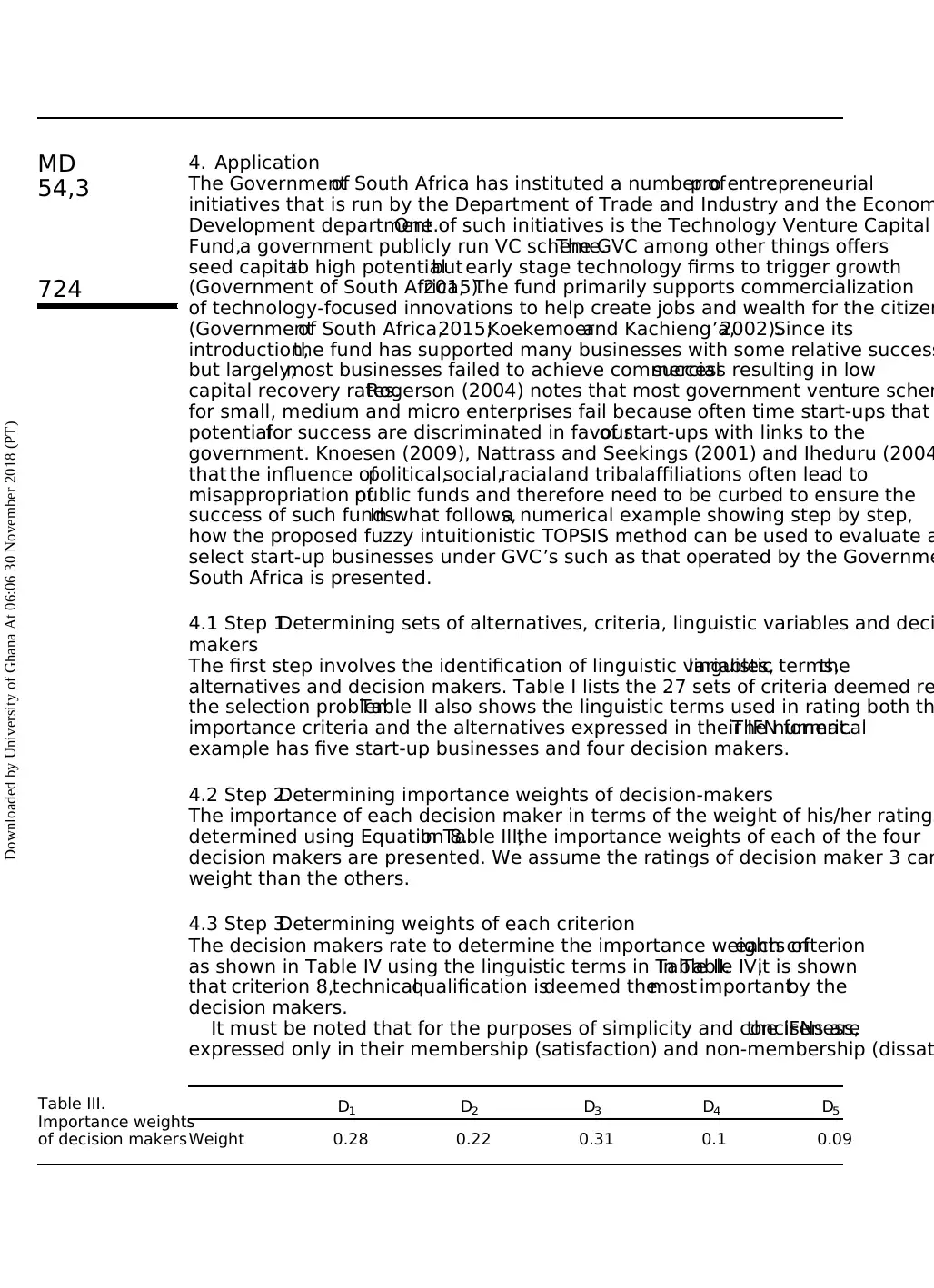
4. Application
The Governmentof South Africa has instituted a number ofpro entrepreneurial
initiatives that is run by the Department of Trade and Industry and the Econom
Development department.One of such initiatives is the Technology Venture Capital
Fund,a government publicly run VC scheme.The GVC among other things offers
seed capitalto high potentialbut early stage technology firms to trigger growth
(Government of South Africa,2015).The fund primarily supports commercialization
of technology-focused innovations to help create jobs and wealth for the citizen
(Governmentof South Africa,2015;Koekemoerand Kachieng’a,2002).Since its
introduction,the fund has supported many businesses with some relative success
but largely,most businesses failed to achieve commercialsuccess resulting in low
capital recovery rates.Rogerson (2004) notes that most government venture schem
for small, medium and micro enterprises fail because often time start-ups that
potentialfor success are discriminated in favourof start-ups with links to the
government. Knoesen (2009), Nattrass and Seekings (2001) and Iheduru (2004
that the influence ofpolitical,social,racialand tribalaffiliations often lead to
misappropriation ofpublic funds and therefore need to be curbed to ensure the
success of such funds.In what follows,a numerical example showing step by step,
how the proposed fuzzy intuitionistic TOPSIS method can be used to evaluate a
select start-up businesses under GVC’s such as that operated by the Governme
South Africa is presented.
4.1 Step 1.Determining sets of alternatives, criteria, linguistic variables and deci
makers
The first step involves the identification of linguistic variables,linguistic terms,the
alternatives and decision makers. Table I lists the 27 sets of criteria deemed re
the selection problem.Table II also shows the linguistic terms used in rating both th
importance criteria and the alternatives expressed in their IFN format.The numerical
example has five start-up businesses and four decision makers.
4.2 Step 2.Determining importance weights of decision-makers
The importance of each decision maker in terms of the weight of his/her ratings
determined using Equation 8.In Table III,the importance weights of each of the four
decision makers are presented. We assume the ratings of decision maker 3 car
weight than the others.
4.3 Step 3.Determining weights of each criterion
The decision makers rate to determine the importance weights ofeach criterion
as shown in Table IV using the linguistic terms in Table II.In Table IV,it is shown
that criterion 8,technicalqualification isdeemed themost importantby the
decision makers.
It must be noted that for the purposes of simplicity and conciseness,the IFNs are
expressed only in their membership (satisfaction) and non-membership (dissat
D1 D2 D3 D4 D5
Weight 0.28 0.22 0.31 0.1 0.09
Table III.
Importance weights
of decision makers
724
MD
54,3
Downloaded by University of Ghana At 06:06 30 November 2018 (PT)
The Governmentof South Africa has instituted a number ofpro entrepreneurial
initiatives that is run by the Department of Trade and Industry and the Econom
Development department.One of such initiatives is the Technology Venture Capital
Fund,a government publicly run VC scheme.The GVC among other things offers
seed capitalto high potentialbut early stage technology firms to trigger growth
(Government of South Africa,2015).The fund primarily supports commercialization
of technology-focused innovations to help create jobs and wealth for the citizen
(Governmentof South Africa,2015;Koekemoerand Kachieng’a,2002).Since its
introduction,the fund has supported many businesses with some relative success
but largely,most businesses failed to achieve commercialsuccess resulting in low
capital recovery rates.Rogerson (2004) notes that most government venture schem
for small, medium and micro enterprises fail because often time start-ups that
potentialfor success are discriminated in favourof start-ups with links to the
government. Knoesen (2009), Nattrass and Seekings (2001) and Iheduru (2004
that the influence ofpolitical,social,racialand tribalaffiliations often lead to
misappropriation ofpublic funds and therefore need to be curbed to ensure the
success of such funds.In what follows,a numerical example showing step by step,
how the proposed fuzzy intuitionistic TOPSIS method can be used to evaluate a
select start-up businesses under GVC’s such as that operated by the Governme
South Africa is presented.
4.1 Step 1.Determining sets of alternatives, criteria, linguistic variables and deci
makers
The first step involves the identification of linguistic variables,linguistic terms,the
alternatives and decision makers. Table I lists the 27 sets of criteria deemed re
the selection problem.Table II also shows the linguistic terms used in rating both th
importance criteria and the alternatives expressed in their IFN format.The numerical
example has five start-up businesses and four decision makers.
4.2 Step 2.Determining importance weights of decision-makers
The importance of each decision maker in terms of the weight of his/her ratings
determined using Equation 8.In Table III,the importance weights of each of the four
decision makers are presented. We assume the ratings of decision maker 3 car
weight than the others.
4.3 Step 3.Determining weights of each criterion
The decision makers rate to determine the importance weights ofeach criterion
as shown in Table IV using the linguistic terms in Table II.In Table IV,it is shown
that criterion 8,technicalqualification isdeemed themost importantby the
decision makers.
It must be noted that for the purposes of simplicity and conciseness,the IFNs are
expressed only in their membership (satisfaction) and non-membership (dissat
D1 D2 D3 D4 D5
Weight 0.28 0.22 0.31 0.1 0.09
Table III.
Importance weights
of decision makers
724
MD
54,3
Downloaded by University of Ghana At 06:06 30 November 2018 (PT)
⊘ This is a preview!⊘
Do you want full access?
Subscribe today to unlock all pages.

Trusted by 1+ million students worldwide
1 out of 23
Your All-in-One AI-Powered Toolkit for Academic Success.
+13062052269
info@desklib.com
Available 24*7 on WhatsApp / Email
![[object Object]](/_next/static/media/star-bottom.7253800d.svg)
Unlock your academic potential
Copyright © 2020–2025 A2Z Services. All Rights Reserved. Developed and managed by ZUCOL.